Washington, DC Map & Demographics
Washington Map
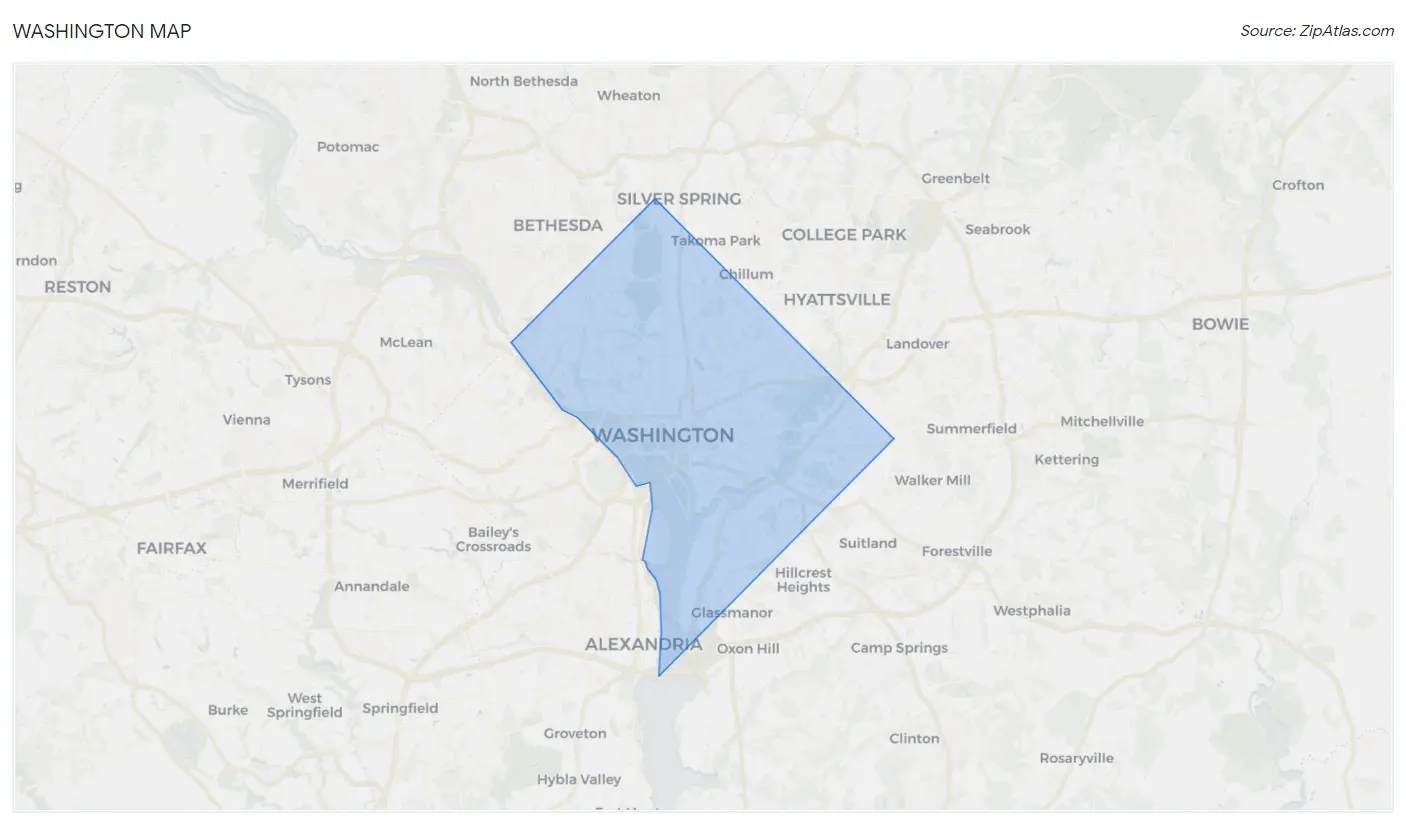
Washington Overview
$71,297
PER CAPITA INCOME
$142,328
AVG FAMILY INCOME
$101,722
AVG HOUSEHOLD INCOME
13.7%
WAGE / INCOME GAP [ % ]
86.3¢/ $1
WAGE / INCOME GAP [ $ ]
$13,486
FAMILY INCOME DEFICIT
0.52
INEQUALITY / GINI INDEX
670,587
TOTAL POPULATION
320,797
MALE POPULATION
349,790
FEMALE POPULATION
91.71
MALES / 100 FEMALES
109.04
FEMALES / 100 MALES
34.8
MEDIAN AGE
3.0
AVG FAMILY SIZE
2.0
AVG HOUSEHOLD SIZE
400,882
LABOR FORCE [ PEOPLE ]
72.0%
PERCENT IN LABOR FORCE
7.1%
UNEMPLOYMENT RATE
Washington Zip Codes
Washington Area Codes
Income in Washington
Income Overview in Washington
Per Capita Income in Washington is $71,297, while median incomes of families and households are $142,328 and $101,722 respectively.
| Characteristic | Number | Measure |
| Per Capita Income | 670,587 | $71,297 |
| Median Family Income | 130,453 | $142,328 |
| Mean Family Income | 130,453 | $199,406 |
| Median Household Income | 315,785 | $101,722 |
| Mean Household Income | 315,785 | $150,292 |
| Income Deficit | 130,453 | $13,486 |
| Wage / Income Gap (%) | 670,587 | 13.67% |
| Wage / Income Gap ($) | 670,587 | 86.33¢ per $1 |
| Gini / Inequality Index | 670,587 | 0.52 |
Earnings by Sex in Washington
Average Earnings in Washington are $75,165, $81,197 for men and $70,095 for women, a difference of 13.7%.

| Sex | Number | Average Earnings |
| Male | 199,435 (48.6%) | $81,197 |
| Female | 210,749 (51.4%) | $70,095 |
| Total | 410,184 (100.0%) | $75,165 |
Earnings by Sex by Income Bracket in Washington
The most common earnings brackets in Washington are $100,000+ for men (80,394 | 40.3%) and $100,000+ for women (67,400 | 32.0%).
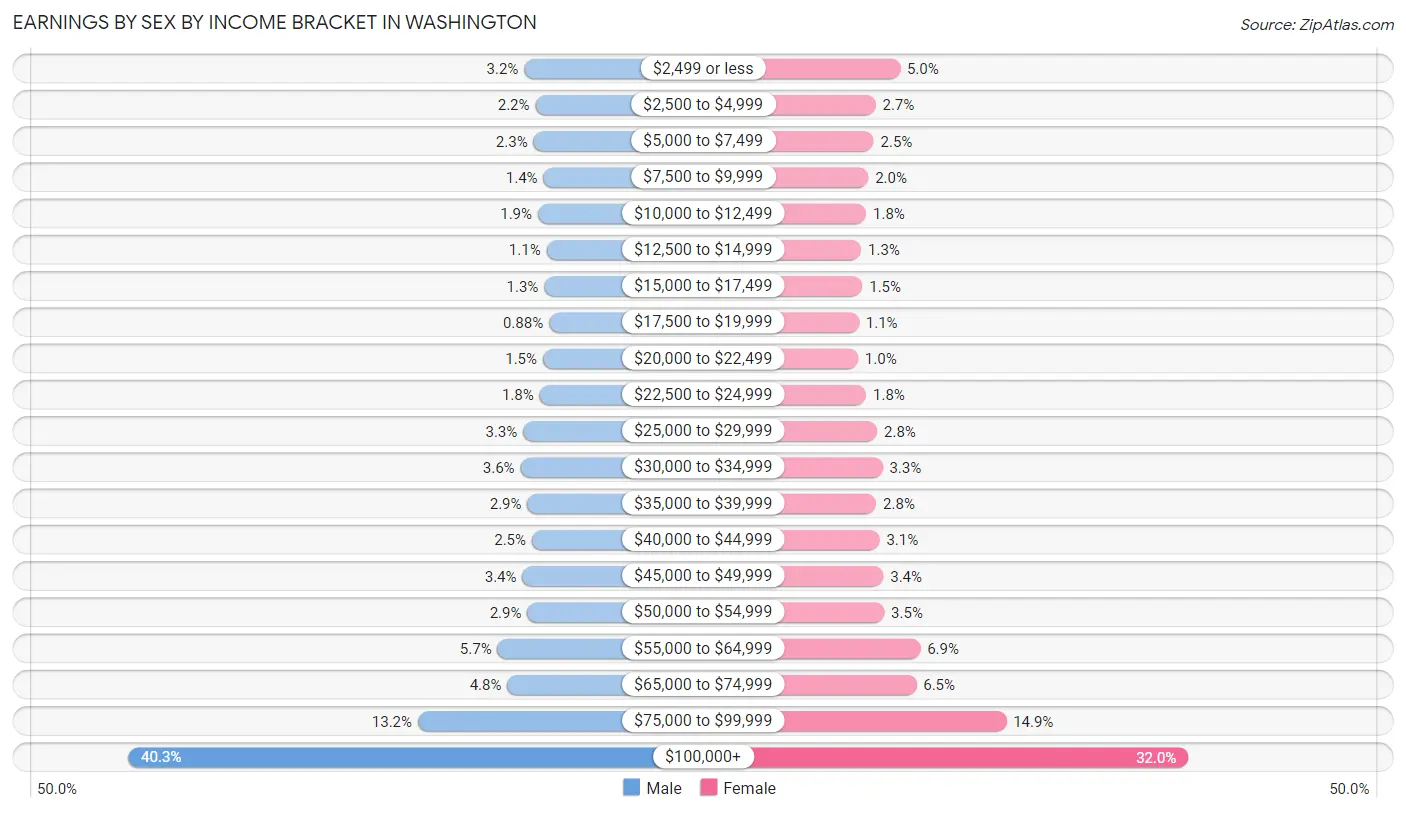
| Income | Male | Female |
| $2,499 or less | 6,385 (3.2%) | 10,492 (5.0%) |
| $2,500 to $4,999 | 4,288 (2.1%) | 5,678 (2.7%) |
| $5,000 to $7,499 | 4,641 (2.3%) | 5,294 (2.5%) |
| $7,500 to $9,999 | 2,799 (1.4%) | 4,232 (2.0%) |
| $10,000 to $12,499 | 3,829 (1.9%) | 3,809 (1.8%) |
| $12,500 to $14,999 | 2,217 (1.1%) | 2,831 (1.3%) |
| $15,000 to $17,499 | 2,662 (1.3%) | 3,063 (1.5%) |
| $17,500 to $19,999 | 1,759 (0.9%) | 2,389 (1.1%) |
| $20,000 to $22,499 | 2,899 (1.5%) | 2,195 (1.0%) |
| $22,500 to $24,999 | 3,520 (1.8%) | 3,818 (1.8%) |
| $25,000 to $29,999 | 6,576 (3.3%) | 5,976 (2.8%) |
| $30,000 to $34,999 | 7,072 (3.5%) | 7,039 (3.3%) |
| $35,000 to $39,999 | 5,791 (2.9%) | 5,797 (2.8%) |
| $40,000 to $44,999 | 4,946 (2.5%) | 6,452 (3.1%) |
| $45,000 to $49,999 | 6,713 (3.4%) | 7,218 (3.4%) |
| $50,000 to $54,999 | 5,805 (2.9%) | 7,370 (3.5%) |
| $55,000 to $64,999 | 11,361 (5.7%) | 14,510 (6.9%) |
| $65,000 to $74,999 | 9,531 (4.8%) | 13,729 (6.5%) |
| $75,000 to $99,999 | 26,247 (13.2%) | 31,457 (14.9%) |
| $100,000+ | 80,394 (40.3%) | 67,400 (32.0%) |
| Total | 199,435 (100.0%) | 210,749 (100.0%) |
Earnings by Sex by Educational Attainment in Washington
Average earnings in Washington are $89,871 for men and $79,048 for women, a difference of 12.0%. Men with an educational attainment of graduate degree enjoy the highest average annual earnings of $130,070, while those with less than high school education earn the least with $35,412. Women with an educational attainment of graduate degree earn the most with the average annual earnings of $109,140, while those with less than high school education have the smallest earnings of $24,901.

| Educational Attainment | Male Income | Female Income |
| Less than High School | $35,412 | $24,901 |
| High School Diploma | $37,522 | $35,004 |
| College or Associate's Degree | $50,547 | $45,491 |
| Bachelor's Degree | $95,449 | $80,235 |
| Graduate Degree | $130,070 | $109,140 |
| Total | $89,871 | $79,048 |
Family Income in Washington
Family Income Brackets in Washington
According to the Washington family income data, there are 48,268 families falling into the $200,000+ income range, which is the most common income bracket and makes up 37.0% of all families. Conversely, the $10,000 to $14,999 income bracket is the least frequent group with only 2,870 families (2.2%) belonging to this category.

| Income Bracket | # Families | % Families |
| Less than $10,000 | 7,044 | 5.4% |
| $10,000 to $14,999 | 2,870 | 2.2% |
| $15,000 to $24,999 | 5,088 | 3.9% |
| $25,000 to $34,999 | 4,696 | 3.6% |
| $35,000 to $49,999 | 8,610 | 6.6% |
| $50,000 to $74,999 | 12,393 | 9.5% |
| $75,000 to $99,999 | 9,914 | 7.6% |
| $100,000 to $149,999 | 16,568 | 12.7% |
| $150,000 to $199,999 | 15,133 | 11.6% |
| $200,000+ | 48,268 | 37.0% |
Family Income by Famaliy Size in Washington
4-person families (20,399 | 15.6%) account for the highest median family income in Washington with $184,525 per family, while 2-person families (68,338 | 52.4%) have the highest median income of $69,392 per family member.

| Income Bracket | # Families | Median Income |
| 2-Person Families | 68,338 (52.4%) | $138,784 |
| 3-Person Families | 29,574 (22.7%) | $138,701 |
| 4-Person Families | 20,399 (15.6%) | $184,525 |
| 5-Person Families | 7,652 (5.9%) | $116,809 |
| 6-Person Families | 2,842 (2.2%) | $114,167 |
| 7+ Person Families | 1,648 (1.3%) | $109,030 |
| Total | 130,453 (100.0%) | $142,328 |
Family Income by Number of Earners in Washington
The median family income in Washington is $142,328, with families comprising 2 earners (66,365) having the highest median family income of $216,750, while families with no earners (16,516) have the lowest median family income of $25,480, accounting for 50.9% and 12.7% of families, respectively.

| Number of Earners | # Families | Median Income |
| No Earners | 16,516 (12.7%) | $25,480 |
| 1 Earner | 39,092 (30.0%) | $74,484 |
| 2 Earners | 66,365 (50.9%) | $216,750 |
| 3+ Earners | 8,480 (6.5%) | $195,039 |
| Total | 130,453 (100.0%) | $142,328 |
Household Income in Washington
Household Income Brackets in Washington
With 75,473 households falling in the category, the $200,000+ income range is the most frequent in Washington, accounting for 23.9% of all households. In contrast, only 11,684 households (3.7%) fall into the $10,000 to $14,999 income bracket, making it the least populous group.

| Income Bracket | # Households | % Households |
| Less than $10,000 | 23,368 | 7.4% |
| $10,000 to $14,999 | 11,684 | 3.7% |
| $15,000 to $24,999 | 15,158 | 4.8% |
| $25,000 to $34,999 | 13,895 | 4.4% |
| $35,000 to $49,999 | 21,789 | 6.9% |
| $50,000 to $74,999 | 35,999 | 11.4% |
| $75,000 to $99,999 | 34,105 | 10.8% |
| $100,000 to $149,999 | 49,578 | 15.7% |
| $150,000 to $199,999 | 34,736 | 11.0% |
| $200,000+ | 75,473 | 23.9% |
Household Income by Householder Age in Washington
The median household income in Washington is $101,722, with the highest median household income of $118,096 found in the 25 to 44 years age bracket for the primary householder. A total of 151,817 households (48.1%) fall into this category. Meanwhile, the 15 to 24 years age bracket for the primary householder has the lowest median household income of $50,160, with 13,809 households (4.4%) in this group.

| Income Bracket | # Households | Median Income |
| 15 to 24 Years | 13,809 (4.4%) | $50,160 |
| 25 to 44 Years | 151,817 (48.1%) | $118,096 |
| 45 to 64 Years | 90,098 (28.5%) | $109,293 |
| 65+ Years | 60,061 (19.0%) | $67,122 |
| Total | 315,785 (100.0%) | $101,722 |
Poverty in Washington
Income Below Poverty by Sex and Age in Washington
With 13.8% poverty level for males and 16.3% for females among the residents of Washington, 18 to 24 year old males and 18 to 24 year old females are the most vulnerable to poverty, with 6,513 males (29.8%) and 7,877 females (30.7%) in their respective age groups living below the poverty level.
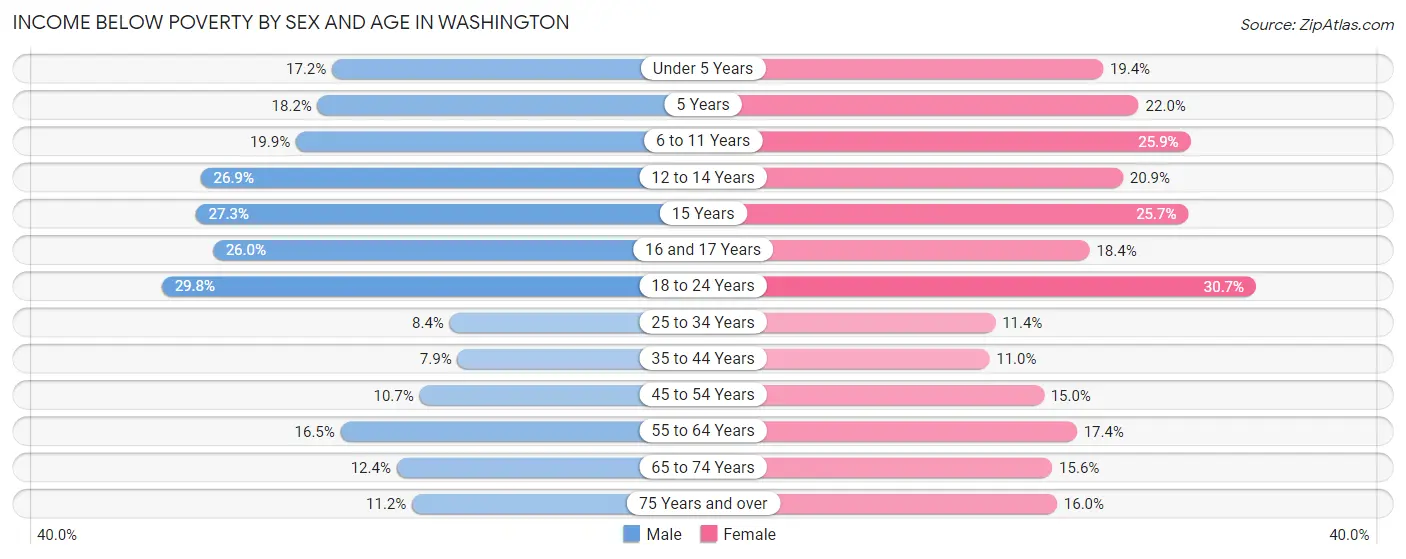
| Age Bracket | Male | Female |
| Under 5 Years | 3,602 (17.2%) | 3,872 (19.4%) |
| 5 Years | 629 (18.2%) | 790 (22.0%) |
| 6 to 11 Years | 4,105 (19.9%) | 5,345 (25.9%) |
| 12 to 14 Years | 2,453 (26.9%) | 1,784 (20.9%) |
| 15 Years | 742 (27.3%) | 665 (25.7%) |
| 16 and 17 Years | 1,264 (26.0%) | 947 (18.4%) |
| 18 to 24 Years | 6,513 (29.8%) | 7,877 (30.7%) |
| 25 to 34 Years | 5,971 (8.4%) | 9,159 (11.4%) |
| 35 to 44 Years | 4,167 (7.9%) | 5,968 (11.0%) |
| 45 to 54 Years | 3,906 (10.7%) | 5,335 (15.0%) |
| 55 to 64 Years | 5,310 (16.5%) | 5,963 (17.4%) |
| 65 to 74 Years | 2,592 (12.4%) | 4,254 (15.6%) |
| 75 Years and over | 1,446 (11.2%) | 3,380 (16.0%) |
| Total | 42,700 (13.8%) | 55,339 (16.3%) |
Income Above Poverty by Sex and Age in Washington
According to the poverty statistics in Washington, males aged 35 to 44 years and females aged 35 to 44 years are the age groups that are most secure financially, with 92.1% of males and 89.0% of females in these age groups living above the poverty line.
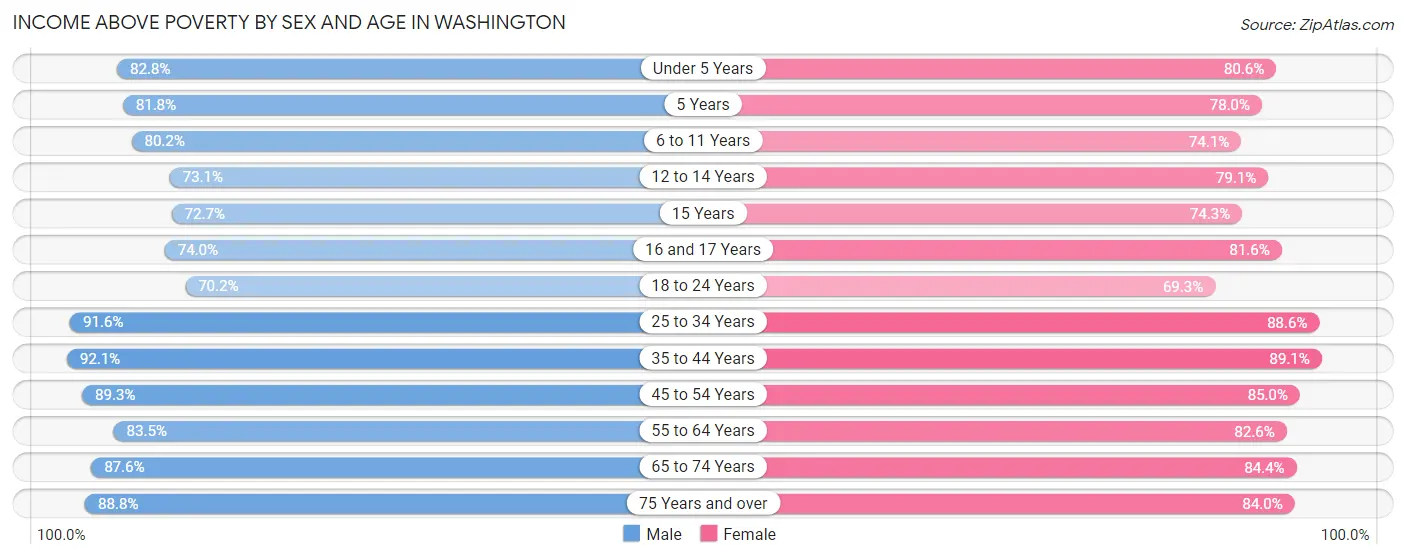
| Age Bracket | Male | Female |
| Under 5 Years | 17,381 (82.8%) | 16,099 (80.6%) |
| 5 Years | 2,819 (81.8%) | 2,794 (78.0%) |
| 6 to 11 Years | 16,575 (80.1%) | 15,305 (74.1%) |
| 12 to 14 Years | 6,656 (73.1%) | 6,763 (79.1%) |
| 15 Years | 1,976 (72.7%) | 1,921 (74.3%) |
| 16 and 17 Years | 3,592 (74.0%) | 4,202 (81.6%) |
| 18 to 24 Years | 15,330 (70.2%) | 17,748 (69.3%) |
| 25 to 34 Years | 64,812 (91.6%) | 71,262 (88.6%) |
| 35 to 44 Years | 48,871 (92.1%) | 48,530 (89.0%) |
| 45 to 54 Years | 32,682 (89.3%) | 30,248 (85.0%) |
| 55 to 64 Years | 26,791 (83.5%) | 28,230 (82.6%) |
| 65 to 74 Years | 18,358 (87.6%) | 22,985 (84.4%) |
| 75 Years and over | 11,427 (88.8%) | 17,788 (84.0%) |
| Total | 267,270 (86.2%) | 283,875 (83.7%) |
Income Below Poverty Among Married-Couple Families in Washington
The poverty statistics for married-couple families in Washington show that 3.0% or 2,382 of the total 79,884 families live below the poverty line. Families with 5 or more children have the highest poverty rate of 15.1%, comprising of 30 families. On the other hand, families with no children have the lowest poverty rate of 2.1%, which includes 990 families.

| Children | Above Poverty | Below Poverty |
| No Children | 46,871 (97.9%) | 990 (2.1%) |
| 1 or 2 Children | 26,152 (96.8%) | 874 (3.2%) |
| 3 or 4 Children | 4,311 (89.8%) | 488 (10.2%) |
| 5 or more Children | 168 (84.9%) | 30 (15.1%) |
| Total | 77,502 (97.0%) | 2,382 (3.0%) |
Income Below Poverty Among Single-Parent Households in Washington
According to the poverty data in Washington, 12.3% or 1,263 single-father households and 26.0% or 10,486 single-mother households are living below the poverty line. Among single-father households, those with 3 or 4 children have the highest poverty rate, with 73 households (23.3%) experiencing poverty. Likewise, among single-mother households, those with 5 or more children have the highest poverty rate, with 267 households (53.6%) falling below the poverty line.

| Children | Single Father | Single Mother |
| No Children | 375 (6.9%) | 2,044 (13.1%) |
| 1 or 2 Children | 815 (18.3%) | 5,842 (29.7%) |
| 3 or 4 Children | 73 (23.3%) | 2,333 (50.4%) |
| 5 or more Children | 0 (0.0%) | 267 (53.6%) |
| Total | 1,263 (12.3%) | 10,486 (26.0%) |
Income Below Poverty Among Married-Couple vs Single-Parent Households in Washington
The poverty data for Washington shows that 2,382 of the married-couple family households (3.0%) and 11,749 of the single-parent households (23.2%) are living below the poverty level. Within the married-couple family households, those with 5 or more children have the highest poverty rate, with 30 households (15.1%) falling below the poverty line. Among the single-parent households, those with 5 or more children have the highest poverty rate, with 267 household (53.6%) living below poverty.

| Children | Married-Couple Families | Single-Parent Households |
| No Children | 990 (2.1%) | 2,419 (11.5%) |
| 1 or 2 Children | 874 (3.2%) | 6,657 (27.6%) |
| 3 or 4 Children | 488 (10.2%) | 2,406 (48.7%) |
| 5 or more Children | 30 (15.1%) | 267 (53.6%) |
| Total | 2,382 (3.0%) | 11,749 (23.2%) |
Race in Washington
The most populous races in Washington are Black / African American (297,101 | 44.3%), White / Caucasian (265,633 | 39.6%), and Hispanic or Latino (77,168 | 11.5%).

| Race | # Population | % Population |
| Asian | 27,067 | 4.0% |
| Black / African American | 297,101 | 44.3% |
| Hawaiian / Pacific | 420 | 0.1% |
| Hispanic or Latino | 77,168 | 11.5% |
| Native / Alaskan | 2,209 | 0.3% |
| White / Caucasian | 265,633 | 39.6% |
| Two or more Races | 47,278 | 7.0% |
| Some other Race | 30,879 | 4.6% |
| Total | 670,587 | 100.0% |
Ancestry in Washington
The most populous ancestries reported in Washington are German (50,711 | 7.6%), Irish (49,862 | 7.4%), English (43,408 | 6.5%), Italian (28,294 | 4.2%), and Central American (27,418 | 4.1%), together accounting for 29.8% of all Washington residents.
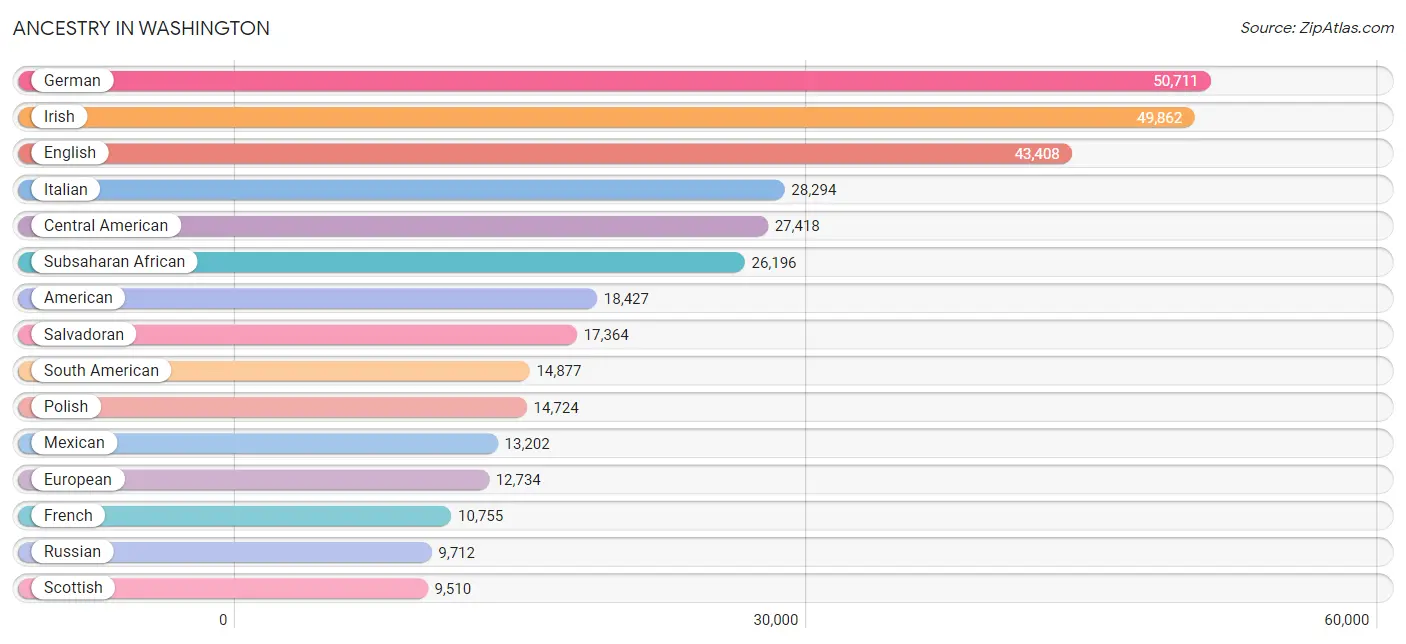
| Ancestry | # Population | % Population |
| Afghan | 141 | 0.0% |
| African | 8,930 | 1.3% |
| Alaska Native | 20 | 0.0% |
| Albanian | 579 | 0.1% |
| Alsatian | 63 | 0.0% |
| American | 18,427 | 2.8% |
| Apache | 187 | 0.0% |
| Arab | 6,041 | 0.9% |
| Argentinean | 1,801 | 0.3% |
| Armenian | 884 | 0.1% |
| Assyrian / Chaldean / Syriac | 80 | 0.0% |
| Australian | 325 | 0.1% |
| Austrian | 2,233 | 0.3% |
| Bahamian | 91 | 0.0% |
| Bangladeshi | 5 | 0.0% |
| Barbadian | 101 | 0.0% |
| Basque | 153 | 0.0% |
| Belgian | 514 | 0.1% |
| Belizean | 116 | 0.0% |
| Bermudan | 85 | 0.0% |
| Bhutanese | 2,719 | 0.4% |
| Blackfeet | 723 | 0.1% |
| Bolivian | 794 | 0.1% |
| Brazilian | 1,250 | 0.2% |
| British | 5,673 | 0.9% |
| British West Indian | 439 | 0.1% |
| Bulgarian | 606 | 0.1% |
| Burmese | 4,502 | 0.7% |
| Cajun | 136 | 0.0% |
| Cambodian | 48 | 0.0% |
| Canadian | 1,228 | 0.2% |
| Cape Verdean | 175 | 0.0% |
| Carpatho Rusyn | 2 | 0.0% |
| Celtic | 49 | 0.0% |
| Central American | 27,418 | 4.1% |
| Central American Indian | 1,358 | 0.2% |
| Cherokee | 1,874 | 0.3% |
| Cheyenne | 3 | 0.0% |
| Chickasaw | 49 | 0.0% |
| Chilean | 1,306 | 0.2% |
| Chinese | 48 | 0.0% |
| Chippewa | 40 | 0.0% |
| Choctaw | 130 | 0.0% |
| Colombian | 5,058 | 0.7% |
| Colville | 59 | 0.0% |
| Comanche | 14 | 0.0% |
| Costa Rican | 1,205 | 0.2% |
| Cree | 38 | 0.0% |
| Creek | 79 | 0.0% |
| Croatian | 839 | 0.1% |
| Cuban | 3,250 | 0.5% |
| Cypriot | 111 | 0.0% |
| Czech | 2,190 | 0.3% |
| Czechoslovakian | 257 | 0.0% |
| Danish | 1,743 | 0.3% |
| Delaware | 12 | 0.0% |
| Dominican | 4,483 | 0.7% |
| Dutch | 4,819 | 0.7% |
| Eastern European | 7,091 | 1.1% |
| Ecuadorian | 946 | 0.1% |
| Egyptian | 613 | 0.1% |
| English | 43,408 | 6.5% |
| Estonian | 90 | 0.0% |
| Ethiopian | 7,736 | 1.1% |
| European | 12,734 | 1.9% |
| Fijian | 16 | 0.0% |
| Filipino | 831 | 0.1% |
| Finnish | 904 | 0.1% |
| French | 10,755 | 1.6% |
| French American Indian | 60 | 0.0% |
| French Canadian | 2,273 | 0.3% |
| German | 50,711 | 7.6% |
| German Russian | 24 | 0.0% |
| Ghanaian | 639 | 0.1% |
| Greek | 3,108 | 0.5% |
| Guamanian / Chamorro | 163 | 0.0% |
| Guatemalan | 3,397 | 0.5% |
| Guyanese | 718 | 0.1% |
| Haitian | 1,484 | 0.2% |
| Hmong | 3 | 0.0% |
| Honduran | 3,073 | 0.5% |
| Hungarian | 2,672 | 0.4% |
| Icelander | 269 | 0.0% |
| Indian (Asian) | 9,401 | 1.4% |
| Indonesian | 198 | 0.0% |
| Inupiat | 9 | 0.0% |
| Iranian | 2,439 | 0.4% |
| Iraqi | 432 | 0.1% |
| Irish | 49,862 | 7.4% |
| Iroquois | 36 | 0.0% |
| Israeli | 696 | 0.1% |
| Italian | 28,294 | 4.2% |
| Jamaican | 6,074 | 0.9% |
| Japanese | 208 | 0.0% |
| Jordanian | 73 | 0.0% |
| Kenyan | 553 | 0.1% |
| Korean | 3,831 | 0.6% |
| Laotian | 430 | 0.1% |
| Latvian | 540 | 0.1% |
| Lebanese | 1,934 | 0.3% |
| Liberian | 208 | 0.0% |
| Lithuanian | 2,487 | 0.4% |
| Lumbee | 39 | 0.0% |
| Luxembourger | 107 | 0.0% |
| Macedonian | 148 | 0.0% |
| Malaysian | 46 | 0.0% |
| Maltese | 135 | 0.0% |
| Mexican | 13,202 | 2.0% |
| Mexican American Indian | 709 | 0.1% |
| Mongolian | 80 | 0.0% |
| Moroccan | 564 | 0.1% |
| Native Hawaiian | 621 | 0.1% |
| Navajo | 103 | 0.0% |
| New Zealander | 162 | 0.0% |
| Nicaraguan | 1,138 | 0.2% |
| Nigerian | 4,069 | 0.6% |
| Northern European | 1,508 | 0.2% |
| Norwegian | 3,790 | 0.6% |
| Okinawan | 18 | 0.0% |
| Osage | 14 | 0.0% |
| Pakistani | 378 | 0.1% |
| Palestinian | 354 | 0.1% |
| Panamanian | 987 | 0.2% |
| Paraguayan | 293 | 0.0% |
| Pennsylvania German | 214 | 0.0% |
| Peruvian | 2,471 | 0.4% |
| Polish | 14,724 | 2.2% |
| Portuguese | 1,360 | 0.2% |
| Potawatomi | 7 | 0.0% |
| Pueblo | 57 | 0.0% |
| Puerto Rican | 6,020 | 0.9% |
| Romanian | 1,392 | 0.2% |
| Russian | 9,712 | 1.5% |
| Salvadoran | 17,364 | 2.6% |
| Samoan | 62 | 0.0% |
| Scandinavian | 1,083 | 0.2% |
| Scotch-Irish | 4,321 | 0.6% |
| Scottish | 9,510 | 1.4% |
| Seminole | 64 | 0.0% |
| Senegalese | 300 | 0.0% |
| Serbian | 438 | 0.1% |
| Sierra Leonean | 277 | 0.0% |
| Sioux | 8 | 0.0% |
| Slavic | 121 | 0.0% |
| Slovak | 1,273 | 0.2% |
| Slovene | 317 | 0.1% |
| Somali | 136 | 0.0% |
| South African | 439 | 0.1% |
| South American | 14,877 | 2.2% |
| South American Indian | 312 | 0.1% |
| Soviet Union | 15 | 0.0% |
| Spaniard | 4,116 | 0.6% |
| Spanish | 1,506 | 0.2% |
| Sri Lankan | 2,763 | 0.4% |
| Subsaharan African | 26,196 | 3.9% |
| Sudanese | 118 | 0.0% |
| Swedish | 5,839 | 0.9% |
| Swiss | 1,733 | 0.3% |
| Syrian | 599 | 0.1% |
| Taiwanese | 15 | 0.0% |
| Thai | 9,497 | 1.4% |
| Tlingit-Haida | 33 | 0.0% |
| Tongan | 23 | 0.0% |
| Trinidadian and Tobagonian | 2,117 | 0.3% |
| Turkish | 1,153 | 0.2% |
| U.S. Virgin Islander | 98 | 0.0% |
| Ugandan | 168 | 0.0% |
| Ukrainian | 3,348 | 0.5% |
| Uruguayan | 492 | 0.1% |
| Venezuelan | 1,649 | 0.3% |
| Vietnamese | 516 | 0.1% |
| Welsh | 3,030 | 0.4% |
| West Indian | 1,501 | 0.2% |
| Yaqui | 19 | 0.0% |
| Yugoslavian | 162 | 0.0% |
| Zimbabwean | 62 | 0.0% | View All 176 Rows |
Immigrants in Washington
The most numerous immigrant groups reported in Washington came from Latin America (37,323 | 5.6%), Asia (19,290 | 2.9%), Central America (19,006 | 2.8%), Africa (15,742 | 2.4%), and Europe (14,780 | 2.2%), together accounting for 15.8% of all Washington residents.
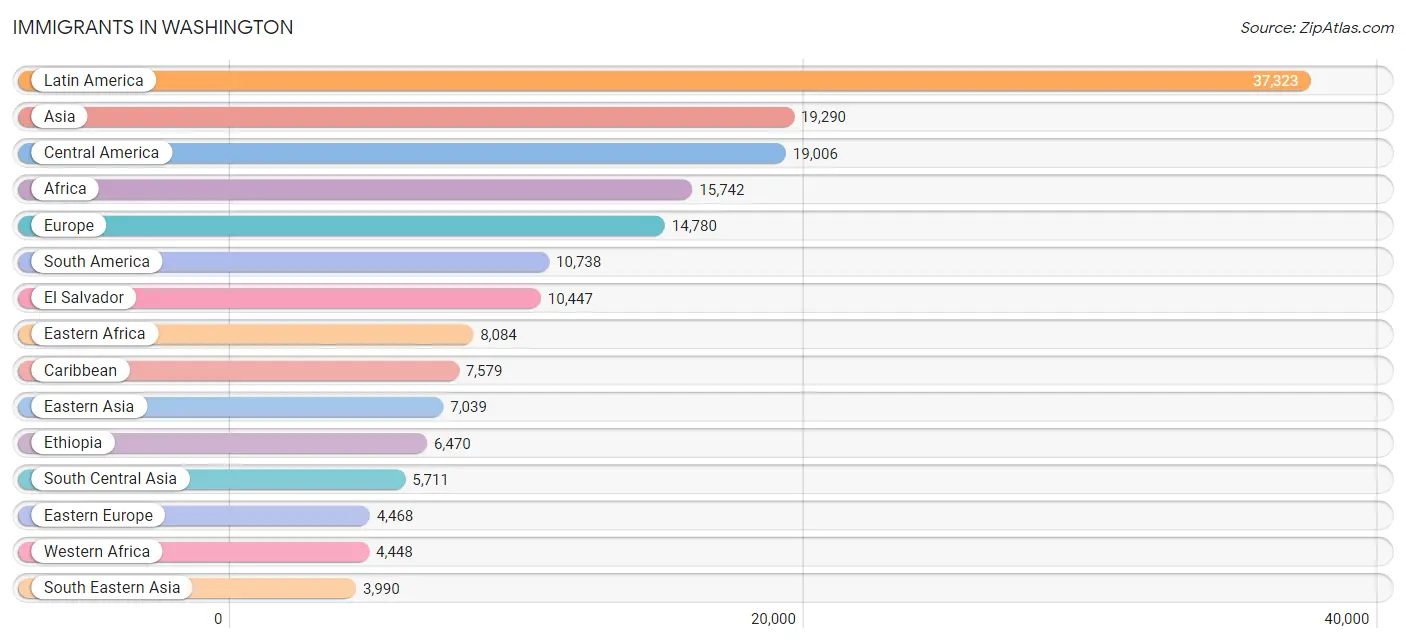
| Immigration Origin | # Population | % Population |
| Afghanistan | 92 | 0.0% |
| Africa | 15,742 | 2.4% |
| Albania | 258 | 0.0% |
| Argentina | 1,026 | 0.2% |
| Armenia | 139 | 0.0% |
| Asia | 19,290 | 2.9% |
| Australia | 603 | 0.1% |
| Austria | 52 | 0.0% |
| Bahamas | 44 | 0.0% |
| Bangladesh | 381 | 0.1% |
| Barbados | 58 | 0.0% |
| Belarus | 162 | 0.0% |
| Belgium | 264 | 0.0% |
| Belize | 49 | 0.0% |
| Bolivia | 461 | 0.1% |
| Brazil | 1,324 | 0.2% |
| Bulgaria | 411 | 0.1% |
| Cabo Verde | 2 | 0.0% |
| Cambodia | 53 | 0.0% |
| Cameroon | 959 | 0.1% |
| Canada | 2,077 | 0.3% |
| Caribbean | 7,579 | 1.1% |
| Central America | 19,006 | 2.8% |
| Chile | 640 | 0.1% |
| China | 3,974 | 0.6% |
| Colombia | 2,899 | 0.4% |
| Congo | 15 | 0.0% |
| Costa Rica | 458 | 0.1% |
| Croatia | 88 | 0.0% |
| Cuba | 635 | 0.1% |
| Czechoslovakia | 205 | 0.0% |
| Denmark | 27 | 0.0% |
| Dominica | 125 | 0.0% |
| Dominican Republic | 2,028 | 0.3% |
| Eastern Africa | 8,084 | 1.2% |
| Eastern Asia | 7,039 | 1.1% |
| Eastern Europe | 4,468 | 0.7% |
| Ecuador | 540 | 0.1% |
| Egypt | 258 | 0.0% |
| El Salvador | 10,447 | 1.6% |
| England | 762 | 0.1% |
| Eritrea | 299 | 0.0% |
| Ethiopia | 6,470 | 1.0% |
| Europe | 14,780 | 2.2% |
| France | 1,612 | 0.2% |
| Germany | 1,465 | 0.2% |
| Ghana | 547 | 0.1% |
| Greece | 281 | 0.0% |
| Grenada | 110 | 0.0% |
| Guatemala | 1,852 | 0.3% |
| Guyana | 556 | 0.1% |
| Haiti | 305 | 0.1% |
| Honduras | 1,685 | 0.3% |
| Hong Kong | 376 | 0.1% |
| Hungary | 134 | 0.0% |
| India | 3,088 | 0.5% |
| Indonesia | 297 | 0.0% |
| Iran | 1,199 | 0.2% |
| Iraq | 176 | 0.0% |
| Ireland | 302 | 0.1% |
| Israel | 402 | 0.1% |
| Italy | 876 | 0.1% |
| Jamaica | 2,468 | 0.4% |
| Japan | 953 | 0.1% |
| Jordan | 42 | 0.0% |
| Kazakhstan | 152 | 0.0% |
| Kenya | 515 | 0.1% |
| Korea | 2,083 | 0.3% |
| Kuwait | 59 | 0.0% |
| Laos | 10 | 0.0% |
| Latin America | 37,323 | 5.6% |
| Latvia | 115 | 0.0% |
| Lebanon | 329 | 0.1% |
| Liberia | 156 | 0.0% |
| Lithuania | 152 | 0.0% |
| Malaysia | 130 | 0.0% |
| Mexico | 3,373 | 0.5% |
| Middle Africa | 1,430 | 0.2% |
| Moldova | 12 | 0.0% |
| Morocco | 443 | 0.1% |
| Nepal | 232 | 0.0% |
| Netherlands | 290 | 0.0% |
| Nicaragua | 699 | 0.1% |
| Nigeria | 2,332 | 0.4% |
| Northern Africa | 985 | 0.2% |
| Northern Europe | 3,527 | 0.5% |
| Norway | 111 | 0.0% |
| Oceania | 795 | 0.1% |
| Pakistan | 413 | 0.1% |
| Panama | 443 | 0.1% |
| Peru | 1,377 | 0.2% |
| Philippines | 1,508 | 0.2% |
| Poland | 292 | 0.0% |
| Portugal | 112 | 0.0% |
| Romania | 361 | 0.1% |
| Russia | 1,075 | 0.2% |
| Saudi Arabia | 215 | 0.0% |
| Scotland | 37 | 0.0% |
| Senegal | 291 | 0.0% |
| Serbia | 225 | 0.0% |
| Sierra Leone | 291 | 0.0% |
| Singapore | 151 | 0.0% |
| Somalia | 37 | 0.0% |
| South Africa | 492 | 0.1% |
| South America | 10,738 | 1.6% |
| South Central Asia | 5,711 | 0.9% |
| South Eastern Asia | 3,990 | 0.6% |
| Southern Europe | 2,901 | 0.4% |
| Spain | 1,632 | 0.2% |
| Sri Lanka | 77 | 0.0% |
| St. Vincent and the Grenadines | 115 | 0.0% |
| Sudan | 91 | 0.0% |
| Sweden | 405 | 0.1% |
| Switzerland | 188 | 0.0% |
| Syria | 223 | 0.0% |
| Taiwan | 334 | 0.1% |
| Thailand | 159 | 0.0% |
| Trinidad and Tobago | 1,494 | 0.2% |
| Turkey | 378 | 0.1% |
| Uganda | 155 | 0.0% |
| Ukraine | 438 | 0.1% |
| Uruguay | 454 | 0.1% |
| Uzbekistan | 77 | 0.0% |
| Venezuela | 1,166 | 0.2% |
| Vietnam | 1,503 | 0.2% |
| West Indies | 37 | 0.0% |
| Western Africa | 4,448 | 0.7% |
| Western Asia | 2,546 | 0.4% |
| Western Europe | 3,871 | 0.6% |
| Zaire | 347 | 0.1% |
| Zimbabwe | 51 | 0.0% | View All 131 Rows |
Sex and Age in Washington
Sex and Age in Washington
The most populous age groups in Washington are 30 to 34 Years (37,440 | 11.7%) for men and 25 to 29 Years (40,563 | 11.6%) for women.
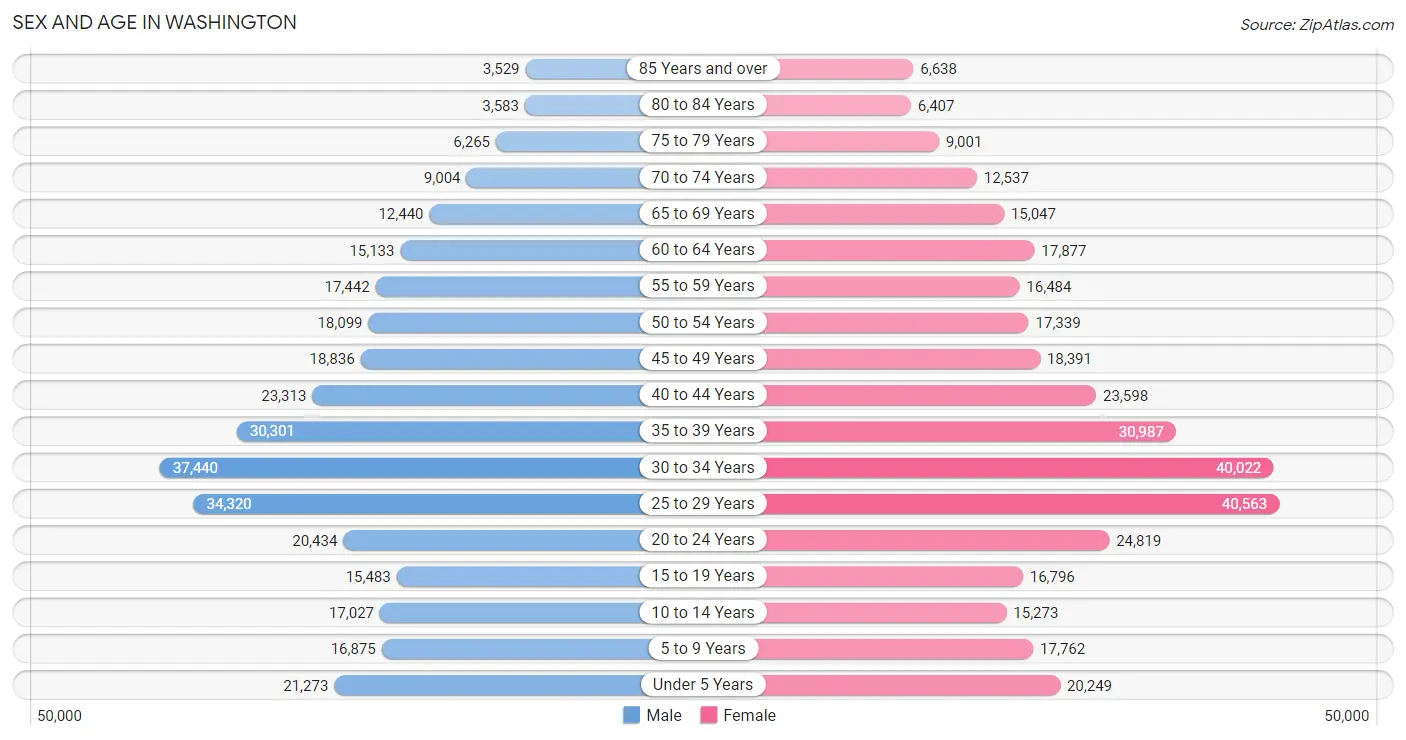
| Age Bracket | Male | Female |
| Under 5 Years | 21,273 (6.6%) | 20,249 (5.8%) |
| 5 to 9 Years | 16,875 (5.3%) | 17,762 (5.1%) |
| 10 to 14 Years | 17,027 (5.3%) | 15,273 (4.4%) |
| 15 to 19 Years | 15,483 (4.8%) | 16,796 (4.8%) |
| 20 to 24 Years | 20,434 (6.4%) | 24,819 (7.1%) |
| 25 to 29 Years | 34,320 (10.7%) | 40,563 (11.6%) |
| 30 to 34 Years | 37,440 (11.7%) | 40,022 (11.4%) |
| 35 to 39 Years | 30,301 (9.5%) | 30,987 (8.9%) |
| 40 to 44 Years | 23,313 (7.3%) | 23,598 (6.8%) |
| 45 to 49 Years | 18,836 (5.9%) | 18,391 (5.3%) |
| 50 to 54 Years | 18,099 (5.6%) | 17,339 (5.0%) |
| 55 to 59 Years | 17,442 (5.4%) | 16,484 (4.7%) |
| 60 to 64 Years | 15,133 (4.7%) | 17,877 (5.1%) |
| 65 to 69 Years | 12,440 (3.9%) | 15,047 (4.3%) |
| 70 to 74 Years | 9,004 (2.8%) | 12,537 (3.6%) |
| 75 to 79 Years | 6,265 (1.9%) | 9,001 (2.6%) |
| 80 to 84 Years | 3,583 (1.1%) | 6,407 (1.8%) |
| 85 Years and over | 3,529 (1.1%) | 6,638 (1.9%) |
| Total | 320,797 (100.0%) | 349,790 (100.0%) |
Families and Households in Washington
Median Family Size in Washington
The median family size in Washington is 3.04 persons per family, with single female/mother families (40,342 | 30.9%) accounting for the largest median family size of 3.37 persons per family. On the other hand, single male/father families (10,227 | 7.8%) represent the smallest median family size with 2.43 persons per family.

| Family Type | # Families | Family Size |
| Married-Couple | 79,884 (61.2%) | 2.95 |
| Single Male/Father | 10,227 (7.8%) | 2.43 |
| Single Female/Mother | 40,342 (30.9%) | 3.37 |
| Total Families | 130,453 (100.0%) | 3.04 |
Median Household Size in Washington
The median household size in Washington is 2.03 persons per household, with single female/mother households (40,342 | 12.8%) accounting for the largest median household size of 3.5 persons per household. non-family households (185,332 | 58.7%) represent the smallest median household size with 1.27 persons per household.

| Household Type | # Households | Household Size |
| Married-Couple | 79,884 (25.3%) | 2.99 |
| Single Male/Father | 10,227 (3.2%) | 2.65 |
| Single Female/Mother | 40,342 (12.8%) | 3.50 |
| Non-family | 185,332 (58.7%) | 1.27 |
| Total Households | 315,785 (100.0%) | 2.03 |
Household Size by Marriage Status in Washington
Out of a total of 315,785 households in Washington, 130,453 (41.3%) are family households, while 185,332 (58.7%) are nonfamily households. The most numerous type of family households are 2-person households, comprising 64,147, and the most common type of nonfamily households are 1-person households, comprising 146,319.

| Household Size | Family Households | Nonfamily Households |
| 1-Person Households | - | 146,319 (46.3%) |
| 2-Person Households | 64,147 (20.3%) | 32,380 (10.2%) |
| 3-Person Households | 30,871 (9.8%) | 3,907 (1.2%) |
| 4-Person Households | 21,227 (6.7%) | 1,586 (0.5%) |
| 5-Person Households | 8,859 (2.8%) | 794 (0.3%) |
| 6-Person Households | 3,310 (1.1%) | 163 (0.1%) |
| 7+ Person Households | 2,039 (0.6%) | 183 (0.1%) |
| Total | 130,453 (41.3%) | 185,332 (58.7%) |
Female Fertility in Washington
Fertility by Age in Washington
Average fertility rate in Washington is 42.0 births per 1,000 women. Women in the age bracket of 20 to 34 years have the highest fertility rate with 47.0 births per 1,000 women. Women in the age bracket of 20 to 34 years acount for 59.2% of all women with births.

| Age Bracket | Women with Births | Births / 1,000 Women |
| 15 to 19 years | 123 (1.5%) | 7.0 |
| 20 to 34 years | 4,937 (59.2%) | 47.0 |
| 35 to 50 years | 3,279 (39.3%) | 43.0 |
| Total | 8,339 (100.0%) | 42.0 |
Fertility by Age by Marriage Status in Washington
56.6% of women with births (8,339) in Washington are married. The highest percentage of unmarried women with births falls into 15 to 19 years age bracket with 100.0% of them unmarried at the time of birth, while the lowest percentage of unmarried women with births belong to 35 to 50 years age bracket with 25.2% of them unmarried.

| Age Bracket | Married | Unmarried |
| 15 to 19 years | 0 (0.0%) | 123 (100.0%) |
| 20 to 34 years | 2,271 (46.0%) | 2,666 (54.0%) |
| 35 to 50 years | 2,453 (74.8%) | 826 (25.2%) |
| Total | 4,720 (56.6%) | 3,619 (43.4%) |
Fertility by Education in Washington
Average fertility rate in Washington is 42.0 births per 1,000 women. Women with the education attainment of less than high school have the highest fertility rate of 56.0 births per 1,000 women, while women with the education attainment of bachelor's degree have the lowest fertility at 32.0 births per 1,000 women. Women with the education attainment of graduate degree represent 32.9% of all women with births.
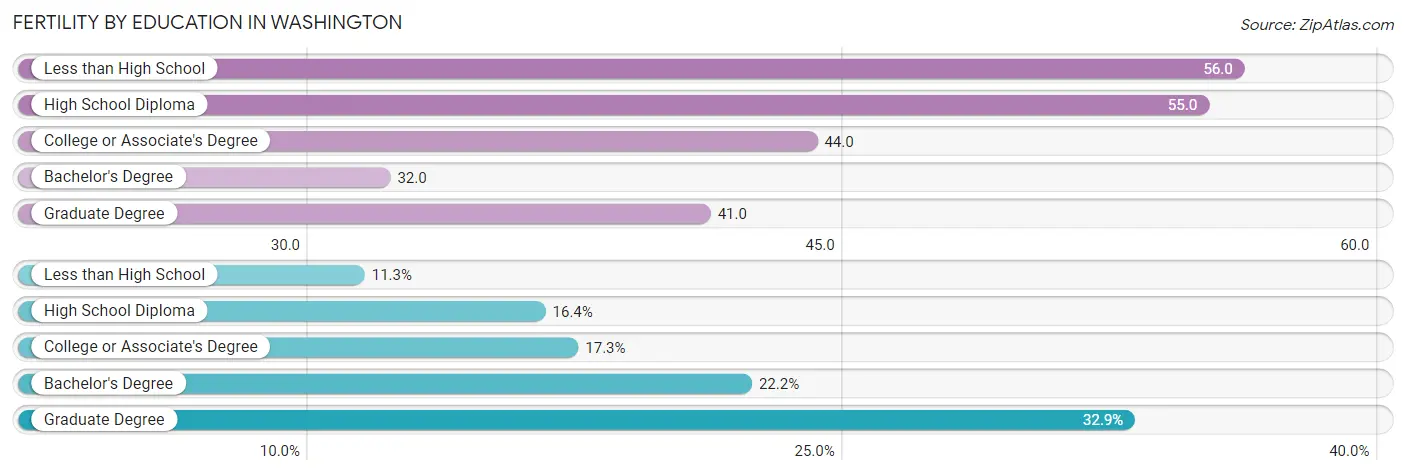
| Educational Attainment | Women with Births | Births / 1,000 Women |
| Less than High School | 941 (11.3%) | 56.0 |
| High School Diploma | 1,364 (16.4%) | 55.0 |
| College or Associate's Degree | 1,441 (17.3%) | 44.0 |
| Bachelor's Degree | 1,848 (22.2%) | 32.0 |
| Graduate Degree | 2,745 (32.9%) | 41.0 |
| Total | 8,339 (100.0%) | 42.0 |
Fertility by Education by Marriage Status in Washington
43.4% of women with births in Washington are unmarried. Women with the educational attainment of graduate degree are most likely to be married with 95.8% of them married at childbirth, while women with the educational attainment of less than high school are least likely to be married with 82.9% of them unmarried at childbirth.

| Educational Attainment | Married | Unmarried |
| Less than High School | 161 (17.1%) | 780 (82.9%) |
| High School Diploma | 246 (18.0%) | 1,118 (82.0%) |
| College or Associate's Degree | 356 (24.7%) | 1,085 (75.3%) |
| Bachelor's Degree | 1,332 (72.1%) | 516 (27.9%) |
| Graduate Degree | 2,630 (95.8%) | 115 (4.2%) |
| Total | 4,720 (56.6%) | 3,619 (43.4%) |
Employment Characteristics in Washington
Employment by Class of Employer in Washington
Among the 366,965 employed individuals in Washington, private company employees (171,653 | 46.8%), not-for-profit organizations (71,618 | 19.5%), and federal government employees (69,582 | 19.0%) make up the most common classes of employment.

| Employer Class | # Employees | % Employees |
| Private Company Employees | 171,653 | 46.8% |
| Self-Employed (Incorporated) | 11,434 | 3.1% |
| Self-Employed (Not Incorporated) | 15,767 | 4.3% |
| Not-for-profit Organizations | 71,618 | 19.5% |
| Local Government Employees | 18,164 | 5.0% |
| State Government Employees | 8,258 | 2.2% |
| Federal Government Employees | 69,582 | 19.0% |
| Unpaid Family Workers | 489 | 0.1% |
| Total | 366,965 | 100.0% |
Employment Status by Age in Washington
According to the labor force statistics for Washington, out of the total population over 16 years of age (556,781), 72.0% or 400,882 individuals are in the labor force, with 7.1% or 28,463 of them unemployed. The age group with the highest labor force participation rate is 30 to 34 years, with 91.1% or 70,568 individuals in the labor force. Within the labor force, the 16 to 19 years age range has the highest percentage of unemployed individuals, with 30.6% or 2,382 of them being unemployed.

| Age Bracket | In Labor Force | Unemployed |
| 16 to 19 Years | 7,783 (28.9%) | 2,382 (30.6%) |
| 20 to 24 Years | 32,899 (72.7%) | 4,902 (14.9%) |
| 25 to 29 Years | 65,073 (86.9%) | 4,295 (6.6%) |
| 30 to 34 Years | 70,568 (91.1%) | 3,599 (5.1%) |
| 35 to 44 Years | 96,838 (89.5%) | 6,004 (6.2%) |
| 45 to 54 Years | 60,893 (83.8%) | 3,410 (5.6%) |
| 55 to 59 Years | 25,173 (74.2%) | 1,460 (5.8%) |
| 60 to 64 Years | 20,598 (62.4%) | 1,483 (7.2%) |
| 65 to 74 Years | 17,552 (35.8%) | 807 (4.6%) |
| 75 Years and over | 3,613 (10.2%) | 177 (4.9%) |
| Total | 400,882 (72.0%) | 28,463 (7.1%) |
Employment Status by Educational Attainment in Washington
According to labor force statistics for Washington, 84.7% of individuals (338,923) out of the total population between 25 and 64 years of age (400,145) are in the labor force, with 6.0% or 20,335 of them being unemployed. The group with the highest labor force participation rate are those with the educational attainment of bachelor's degree or higher, with 92.7% or 243,065 individuals in the labor force. Within the labor force, individuals with less than high school education have the highest percentage of unemployment, with 23.0% or 3,141 of them being unemployed.

| Educational Attainment | In Labor Force | Unemployed |
| Less than High School | 13,657 (54.5%) | 5,764 (23.0%) |
| High School Diploma | 37,541 (68.0%) | 9,220 (16.7%) |
| College / Associate Degree | 44,870 (77.8%) | 6,748 (11.7%) |
| Bachelor's Degree or higher | 243,065 (92.7%) | 6,031 (2.3%) |
| Total | 338,923 (84.7%) | 24,009 (6.0%) |
Employment Occupations by Sex in Washington
Management, Business, Science and Arts Occupations
The most common Management, Business, Science and Arts occupations in Washington are Community & Social Service (83,687 | 22.7%), Management (65,299 | 17.7%), Computers, Engineering & Science (47,738 | 12.9%), Business & Financial (45,682 | 12.4%), and Legal Services & Support (30,879 | 8.4%).
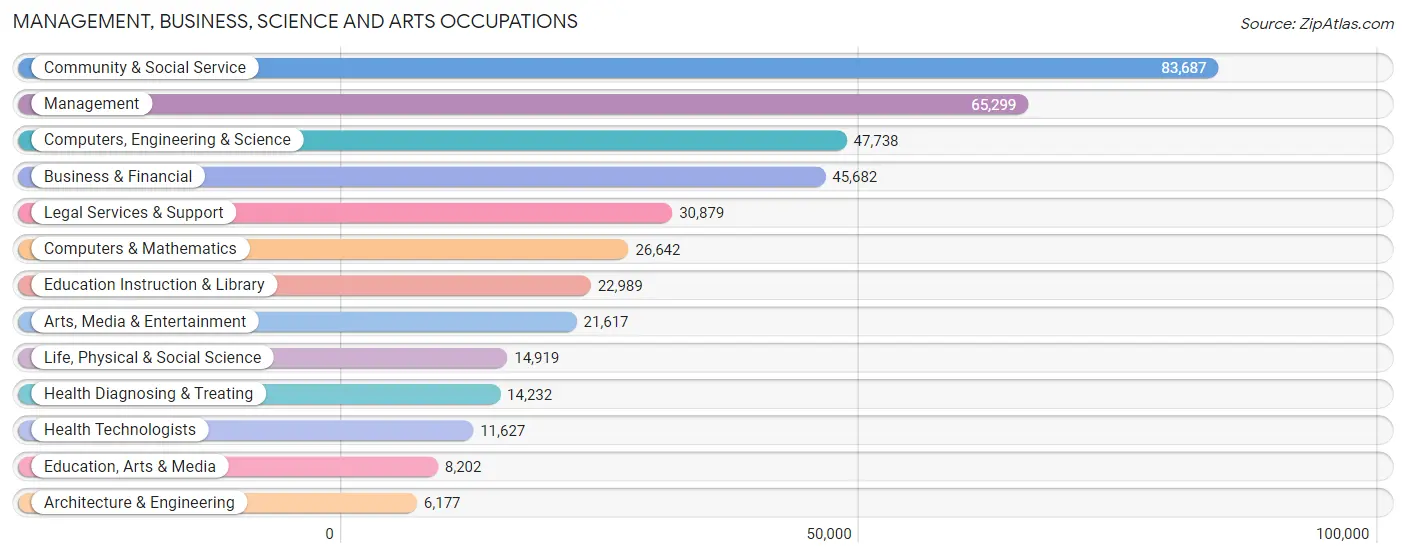
Management, Business, Science and Arts Occupations by Sex
Within the Management, Business, Science and Arts occupations in Washington, the most male-oriented occupations are Architecture & Engineering (72.2%), Computers & Mathematics (63.3%), and Computers, Engineering & Science (60.1%), while the most female-oriented occupations are Health Technologists (66.6%), Education Instruction & Library (66.4%), and Health Diagnosing & Treating (65.6%).
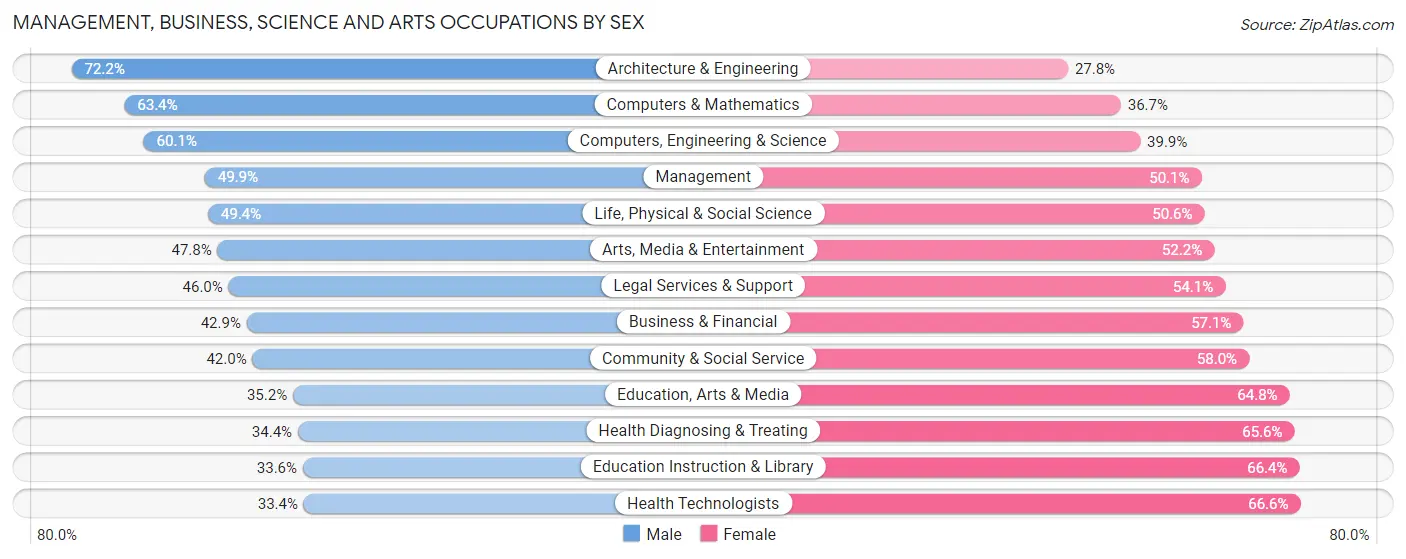
| Occupation | Male | Female |
| Management | 32,600 (49.9%) | 32,699 (50.1%) |
| Business & Financial | 19,611 (42.9%) | 26,071 (57.1%) |
| Computers, Engineering & Science | 28,707 (60.1%) | 19,031 (39.9%) |
| Computers & Mathematics | 16,878 (63.3%) | 9,764 (36.6%) |
| Architecture & Engineering | 4,458 (72.2%) | 1,719 (27.8%) |
| Life, Physical & Social Science | 7,371 (49.4%) | 7,548 (50.6%) |
| Community & Social Service | 35,125 (42.0%) | 48,562 (58.0%) |
| Education, Arts & Media | 2,888 (35.2%) | 5,314 (64.8%) |
| Legal Services & Support | 14,189 (46.0%) | 16,690 (54.0%) |
| Education Instruction & Library | 7,716 (33.6%) | 15,273 (66.4%) |
| Arts, Media & Entertainment | 10,332 (47.8%) | 11,285 (52.2%) |
| Health Diagnosing & Treating | 4,895 (34.4%) | 9,337 (65.6%) |
| Health Technologists | 3,883 (33.4%) | 7,744 (66.6%) |
| Total (Category) | 120,938 (47.1%) | 135,700 (52.9%) |
| Total (Overall) | 178,439 (48.3%) | 190,959 (51.7%) |
Services Occupations
The most common Services occupations in Washington are Food Preparation & Serving (14,164 | 3.8%), Security & Protection (9,027 | 2.4%), Personal Care & Service (7,954 | 2.1%), Cleaning & Maintenance (7,749 | 2.1%), and Firefighting & Prevention (6,457 | 1.8%).

Services Occupations by Sex
Within the Services occupations in Washington, the most male-oriented occupations are Law Enforcement (71.2%), Cleaning & Maintenance (53.0%), and Security & Protection (52.3%), while the most female-oriented occupations are Personal Care & Service (76.9%), Healthcare Support (71.9%), and Firefighting & Prevention (55.2%).

| Occupation | Male | Female |
| Healthcare Support | 1,453 (28.1%) | 3,719 (71.9%) |
| Security & Protection | 4,723 (52.3%) | 4,304 (47.7%) |
| Firefighting & Prevention | 2,893 (44.8%) | 3,564 (55.2%) |
| Law Enforcement | 1,830 (71.2%) | 740 (28.8%) |
| Food Preparation & Serving | 7,098 (50.1%) | 7,066 (49.9%) |
| Cleaning & Maintenance | 4,107 (53.0%) | 3,642 (47.0%) |
| Personal Care & Service | 1,838 (23.1%) | 6,116 (76.9%) |
| Total (Category) | 19,219 (43.6%) | 24,847 (56.4%) |
| Total (Overall) | 178,439 (48.3%) | 190,959 (51.7%) |
Sales and Office Occupations
The most common Sales and Office occupations in Washington are Office & Administration (28,028 | 7.6%), and Sales & Related (19,862 | 5.4%).

Sales and Office Occupations by Sex

| Occupation | Male | Female |
| Sales & Related | 10,689 (53.8%) | 9,173 (46.2%) |
| Office & Administration | 9,807 (35.0%) | 18,221 (65.0%) |
| Total (Category) | 20,496 (42.8%) | 27,394 (57.2%) |
| Total (Overall) | 178,439 (48.3%) | 190,959 (51.7%) |
Natural Resources, Construction and Maintenance Occupations
The most common Natural Resources, Construction and Maintenance occupations in Washington are Construction & Extraction (5,616 | 1.5%), Installation, Maintenance & Repair (2,723 | 0.7%), and Farming, Fishing & Forestry (141 | 0.0%).

Natural Resources, Construction and Maintenance Occupations by Sex

| Occupation | Male | Female |
| Farming, Fishing & Forestry | 16 (11.4%) | 125 (88.6%) |
| Construction & Extraction | 5,372 (95.7%) | 244 (4.3%) |
| Installation, Maintenance & Repair | 2,490 (91.4%) | 233 (8.6%) |
| Total (Category) | 7,878 (92.9%) | 602 (7.1%) |
| Total (Overall) | 178,439 (48.3%) | 190,959 (51.7%) |
Production, Transportation and Moving Occupations
The most common Production, Transportation and Moving occupations in Washington are Transportation (6,747 | 1.8%), Material Moving (3,342 | 0.9%), and Production (2,235 | 0.6%).

Production, Transportation and Moving Occupations by Sex

| Occupation | Male | Female |
| Production | 1,670 (74.7%) | 565 (25.3%) |
| Transportation | 5,527 (81.9%) | 1,220 (18.1%) |
| Material Moving | 2,711 (81.1%) | 631 (18.9%) |
| Total (Category) | 9,908 (80.4%) | 2,416 (19.6%) |
| Total (Overall) | 178,439 (48.3%) | 190,959 (51.7%) |
Employment Industries by Sex in Washington
Employment Industries in Washington
The major employment industries in Washington include Professional & Scientific (78,885 | 21.4%), Public Administration (63,960 | 17.3%), Educational Services (32,787 | 8.9%), Health Care & Social Assistance (32,098 | 8.7%), and Accommodation & Food Services (19,040 | 5.1%).
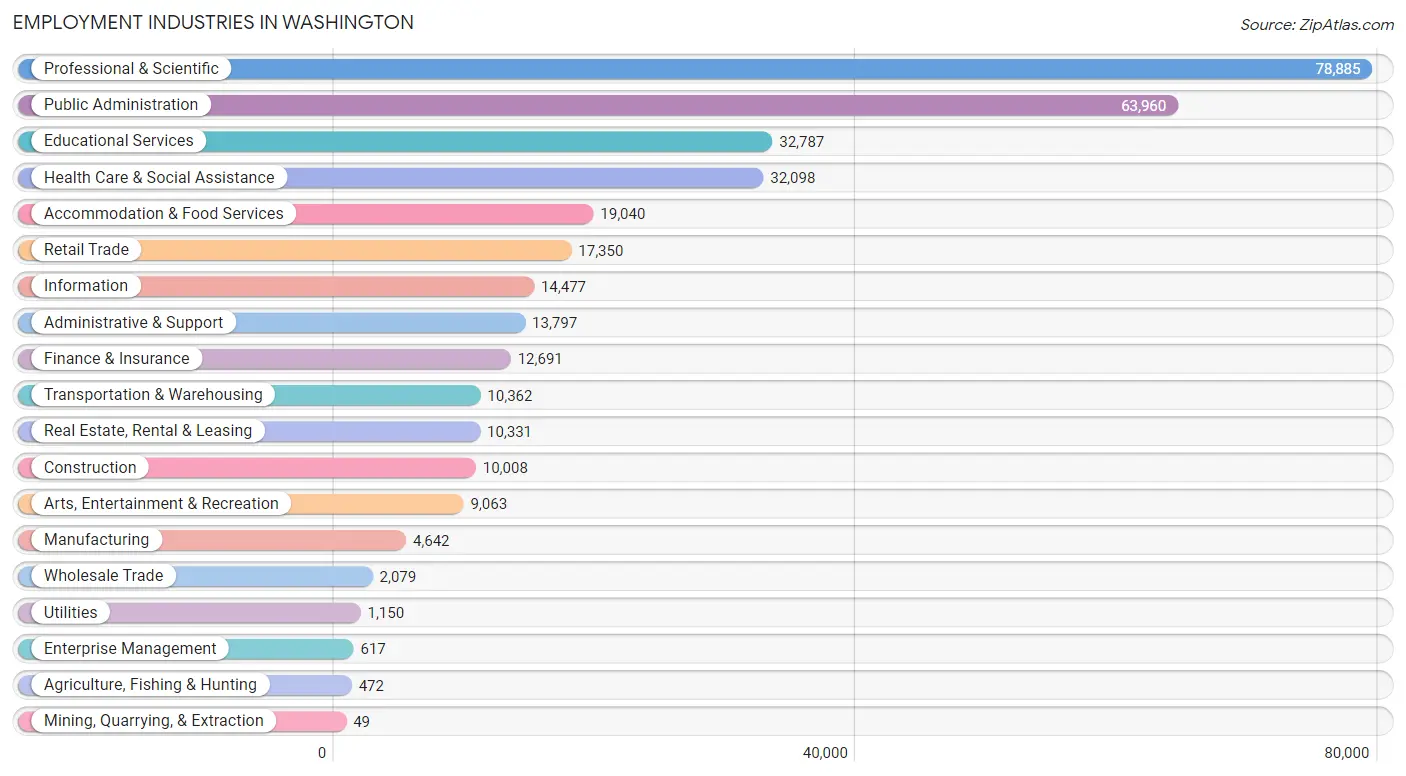
Employment Industries by Sex in Washington
The Washington industries that see more men than women are Construction (80.1%), Utilities (77.2%), and Wholesale Trade (76.5%), whereas the industries that tend to have a higher number of women are Mining, Quarrying, & Extraction (100.0%), Agriculture, Fishing & Hunting (82.6%), and Health Care & Social Assistance (69.1%).
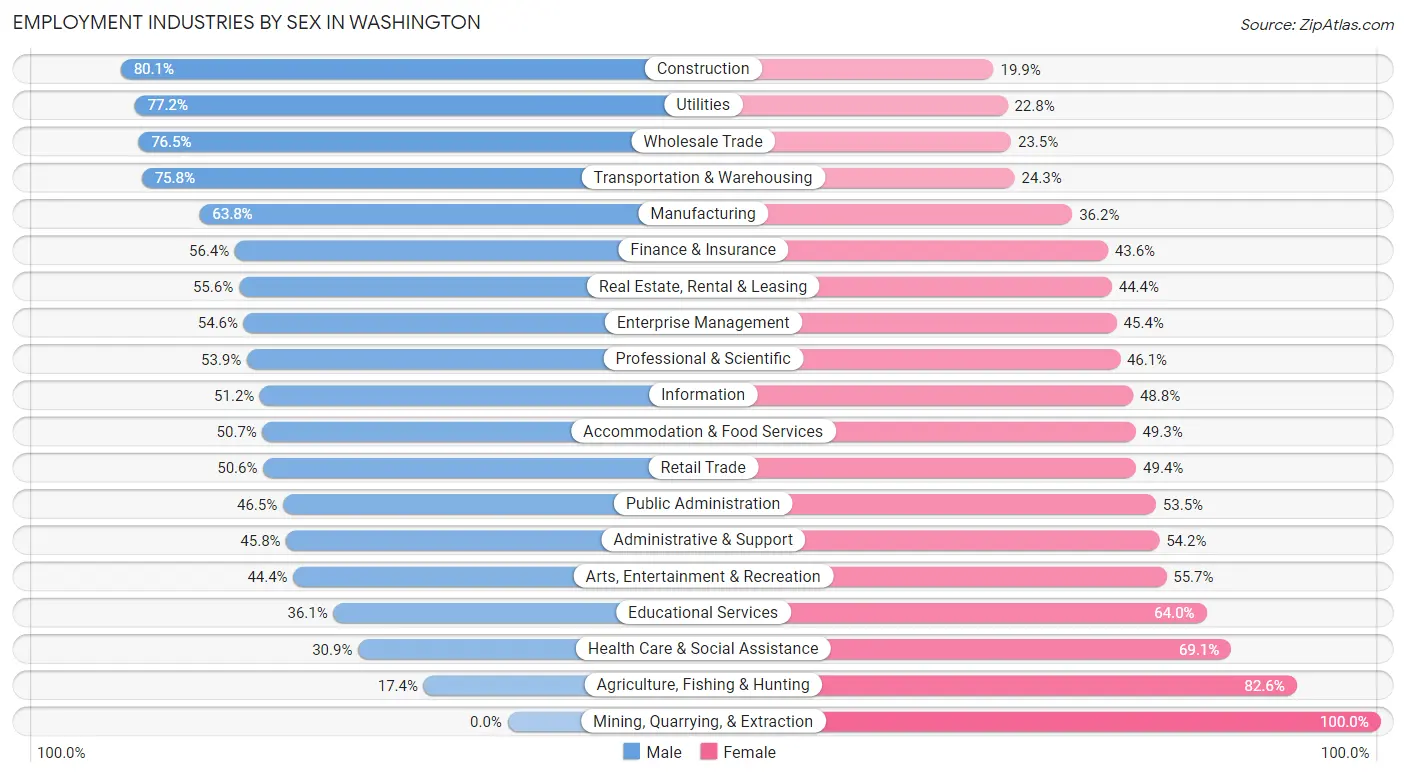
| Industry | Male | Female |
| Agriculture, Fishing & Hunting | 82 (17.4%) | 390 (82.6%) |
| Mining, Quarrying, & Extraction | 0 (0.0%) | 49 (100.0%) |
| Construction | 8,016 (80.1%) | 1,992 (19.9%) |
| Manufacturing | 2,962 (63.8%) | 1,680 (36.2%) |
| Wholesale Trade | 1,590 (76.5%) | 489 (23.5%) |
| Retail Trade | 8,778 (50.6%) | 8,572 (49.4%) |
| Transportation & Warehousing | 7,849 (75.7%) | 2,513 (24.2%) |
| Utilities | 888 (77.2%) | 262 (22.8%) |
| Information | 7,418 (51.2%) | 7,059 (48.8%) |
| Finance & Insurance | 7,161 (56.4%) | 5,530 (43.6%) |
| Real Estate, Rental & Leasing | 5,747 (55.6%) | 4,584 (44.4%) |
| Professional & Scientific | 42,552 (53.9%) | 36,333 (46.1%) |
| Enterprise Management | 337 (54.6%) | 280 (45.4%) |
| Administrative & Support | 6,321 (45.8%) | 7,476 (54.2%) |
| Educational Services | 11,821 (36.0%) | 20,966 (63.9%) |
| Health Care & Social Assistance | 9,931 (30.9%) | 22,167 (69.1%) |
| Arts, Entertainment & Recreation | 4,019 (44.4%) | 5,044 (55.6%) |
| Accommodation & Food Services | 9,658 (50.7%) | 9,382 (49.3%) |
| Public Administration | 29,739 (46.5%) | 34,221 (53.5%) |
| Total | 178,439 (48.3%) | 190,959 (51.7%) |
Education in Washington
School Enrollment in Washington
The most common levels of schooling among the 156,326 students in Washington are college / undergraduate (35,568 | 22.8%), elementary school (27,222 | 17.4%), and middle school (24,556 | 15.7%).

| School Level | # Students | % Students |
| Nursery / Preschool | 14,557 | 9.3% |
| Kindergarten | 8,179 | 5.2% |
| Elementary School | 27,222 | 17.4% |
| Middle School | 24,556 | 15.7% |
| High School | 22,875 | 14.6% |
| College / Undergraduate | 35,568 | 22.8% |
| Graduate / Professional | 23,369 | 14.9% |
| Total | 156,326 | 100.0% |
School Enrollment by Age by Funding Source in Washington
Out of a total of 156,326 students who are enrolled in schools in Washington, 56,746 (36.3%) attend a private institution, while the remaining 99,580 (63.7%) are enrolled in public schools. The age group of 20 to 24 year olds has the highest likelihood of being enrolled in private schools, with 14,069 (76.1% in the age bracket) enrolled. Conversely, the age group of 5 to 9 year old has the lowest likelihood of being enrolled in a private school, with 29,084 (87.3% in the age bracket) attending a public institution.

| Age Bracket | Public School | Private School |
| 3 to 4 Year Olds | 10,250 (76.2%) | 3,204 (23.8%) |
| 5 to 9 Year Old | 29,084 (87.3%) | 4,219 (12.7%) |
| 10 to 14 Year Olds | 25,951 (82.9%) | 5,361 (17.1%) |
| 15 to 17 Year Olds | 11,990 (79.8%) | 3,031 (20.2%) |
| 18 to 19 Year Olds | 3,986 (28.6%) | 9,971 (71.4%) |
| 20 to 24 Year Olds | 4,415 (23.9%) | 14,069 (76.1%) |
| 25 to 34 Year Olds | 7,548 (38.8%) | 11,921 (61.2%) |
| 35 Years and over | 6,363 (56.2%) | 4,963 (43.8%) |
| Total | 99,580 (63.7%) | 56,746 (36.3%) |
Educational Attainment by Field of Study in Washington
Social sciences (89,758 | 26.0%), business (41,444 | 12.0%), liberal arts & history (31,057 | 9.0%), literature & languages (28,114 | 8.2%), and communications (19,553 | 5.7%) are the most common fields of study among 345,038 individuals in Washington who have obtained a bachelor's degree or higher.
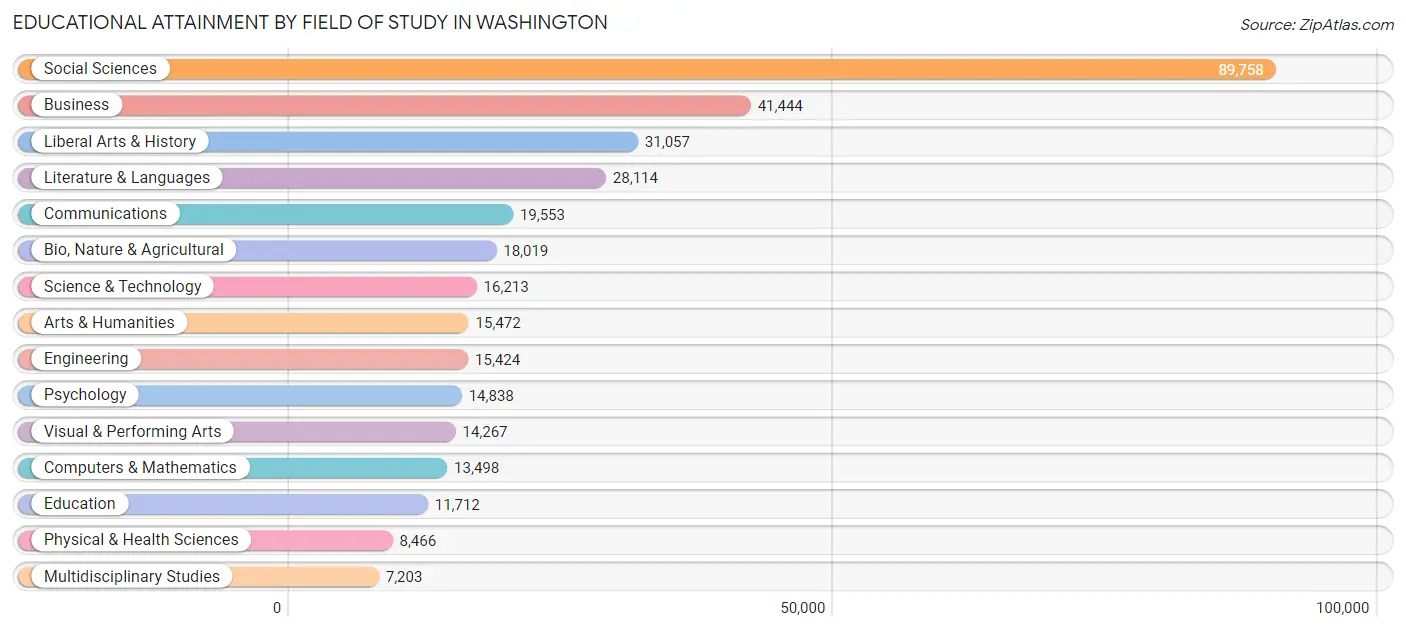
| Field of Study | # Graduates | % Graduates |
| Computers & Mathematics | 13,498 | 3.9% |
| Bio, Nature & Agricultural | 18,019 | 5.2% |
| Physical & Health Sciences | 8,466 | 2.5% |
| Psychology | 14,838 | 4.3% |
| Social Sciences | 89,758 | 26.0% |
| Engineering | 15,424 | 4.5% |
| Multidisciplinary Studies | 7,203 | 2.1% |
| Science & Technology | 16,213 | 4.7% |
| Business | 41,444 | 12.0% |
| Education | 11,712 | 3.4% |
| Literature & Languages | 28,114 | 8.2% |
| Liberal Arts & History | 31,057 | 9.0% |
| Visual & Performing Arts | 14,267 | 4.1% |
| Communications | 19,553 | 5.7% |
| Arts & Humanities | 15,472 | 4.5% |
| Total | 345,038 | 100.0% |
Transportation & Commute in Washington
Vehicle Availability by Sex in Washington
The most prevalent vehicle ownership categories in Washington are males with 1 vehicle (80,205, accounting for 45.6%) and females with 1 vehicle (87,501, making up 43.4%).

| Vehicles Available | Male | Female |
| No Vehicle | 42,663 (24.3%) | 51,000 (27.6%) |
| 1 Vehicle | 80,205 (45.6%) | 87,501 (47.3%) |
| 2 Vehicles | 39,758 (22.6%) | 34,826 (18.8%) |
| 3 Vehicles | 9,409 (5.3%) | 8,199 (4.4%) |
| 4 Vehicles | 2,816 (1.6%) | 2,515 (1.4%) |
| 5 or more Vehicles | 995 (0.6%) | 839 (0.4%) |
| Total | 175,846 (100.0%) | 184,880 (100.0%) |
Commute Time in Washington
The most frequently occuring commute durations in Washington are 30 to 34 minutes (57,619 commuters, 20.9%), 20 to 24 minutes (40,438 commuters, 14.7%), and 45 to 59 minutes (32,712 commuters, 11.9%).
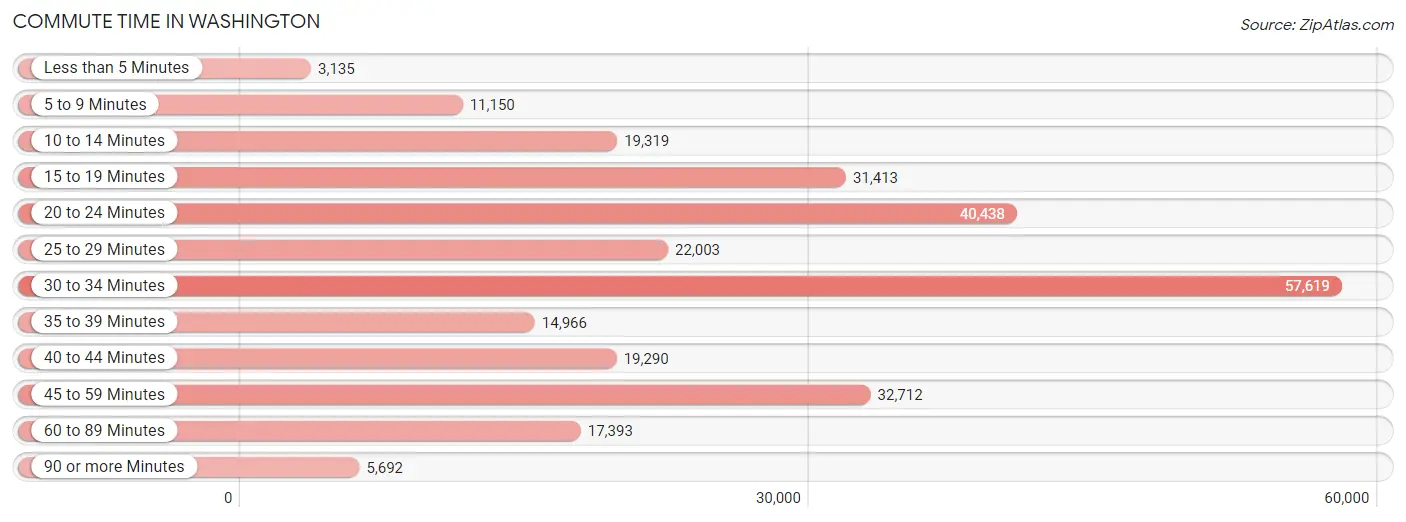
| Commute Time | # Commuters | % Commuters |
| Less than 5 Minutes | 3,135 | 1.1% |
| 5 to 9 Minutes | 11,150 | 4.1% |
| 10 to 14 Minutes | 19,319 | 7.0% |
| 15 to 19 Minutes | 31,413 | 11.4% |
| 20 to 24 Minutes | 40,438 | 14.7% |
| 25 to 29 Minutes | 22,003 | 8.0% |
| 30 to 34 Minutes | 57,619 | 20.9% |
| 35 to 39 Minutes | 14,966 | 5.4% |
| 40 to 44 Minutes | 19,290 | 7.0% |
| 45 to 59 Minutes | 32,712 | 11.9% |
| 60 to 89 Minutes | 17,393 | 6.3% |
| 90 or more Minutes | 5,692 | 2.1% |
Commute Time by Sex in Washington
The most common commute times in Washington are 30 to 34 minutes (27,941 commuters, 20.5%) for males and 30 to 34 minutes (29,678 commuters, 21.4%) for females.
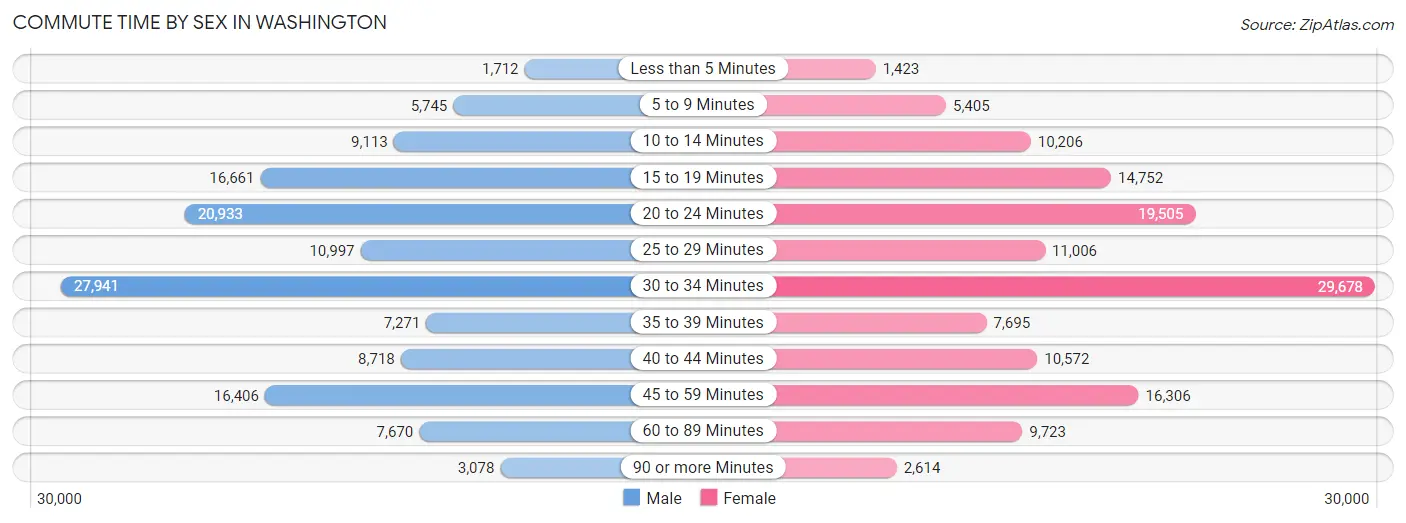
| Commute Time | Male | Female |
| Less than 5 Minutes | 1,712 (1.3%) | 1,423 (1.0%) |
| 5 to 9 Minutes | 5,745 (4.2%) | 5,405 (3.9%) |
| 10 to 14 Minutes | 9,113 (6.7%) | 10,206 (7.3%) |
| 15 to 19 Minutes | 16,661 (12.2%) | 14,752 (10.6%) |
| 20 to 24 Minutes | 20,933 (15.4%) | 19,505 (14.0%) |
| 25 to 29 Minutes | 10,997 (8.1%) | 11,006 (7.9%) |
| 30 to 34 Minutes | 27,941 (20.5%) | 29,678 (21.4%) |
| 35 to 39 Minutes | 7,271 (5.3%) | 7,695 (5.5%) |
| 40 to 44 Minutes | 8,718 (6.4%) | 10,572 (7.6%) |
| 45 to 59 Minutes | 16,406 (12.0%) | 16,306 (11.7%) |
| 60 to 89 Minutes | 7,670 (5.6%) | 9,723 (7.0%) |
| 90 or more Minutes | 3,078 (2.3%) | 2,614 (1.9%) |
Time of Departure to Work by Sex in Washington
The most frequent times of departure to work in Washington are 8:00 AM to 8:29 AM (25,692, 18.9%) for males and 8:00 AM to 8:29 AM (29,112, 21.0%) for females.
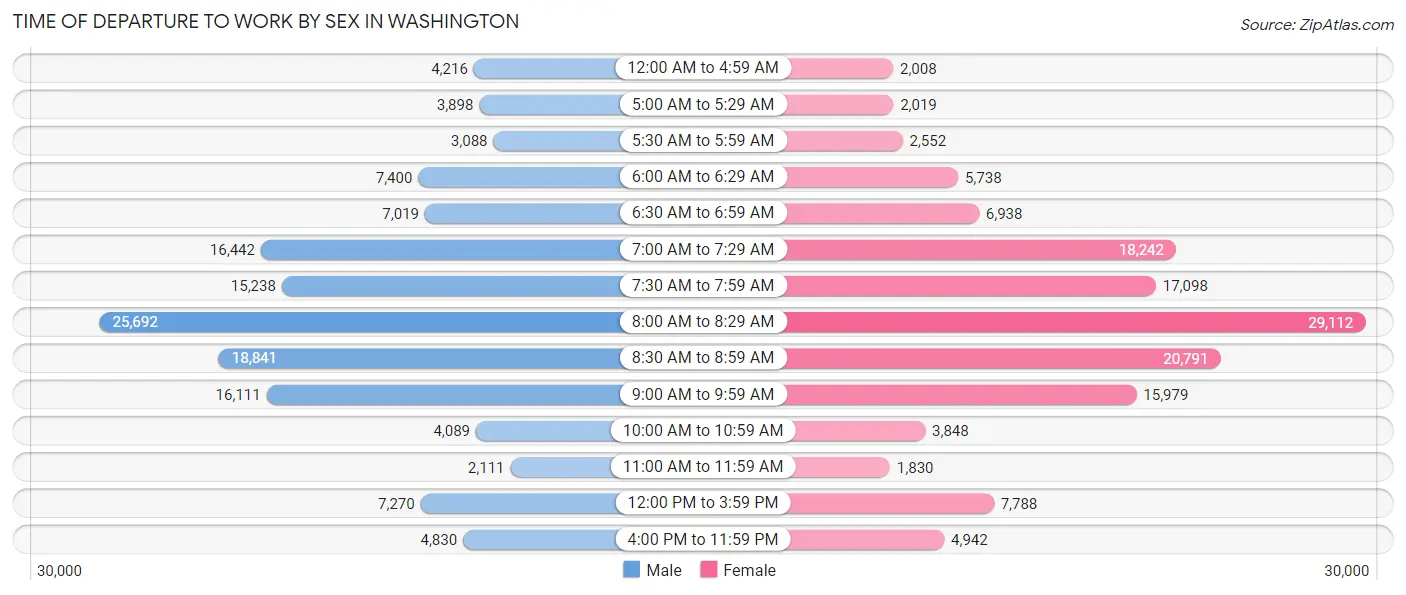
| Time of Departure | Male | Female |
| 12:00 AM to 4:59 AM | 4,216 (3.1%) | 2,008 (1.5%) |
| 5:00 AM to 5:29 AM | 3,898 (2.9%) | 2,019 (1.5%) |
| 5:30 AM to 5:59 AM | 3,088 (2.3%) | 2,552 (1.8%) |
| 6:00 AM to 6:29 AM | 7,400 (5.4%) | 5,738 (4.1%) |
| 6:30 AM to 6:59 AM | 7,019 (5.1%) | 6,938 (5.0%) |
| 7:00 AM to 7:29 AM | 16,442 (12.1%) | 18,242 (13.1%) |
| 7:30 AM to 7:59 AM | 15,238 (11.2%) | 17,098 (12.3%) |
| 8:00 AM to 8:29 AM | 25,692 (18.9%) | 29,112 (21.0%) |
| 8:30 AM to 8:59 AM | 18,841 (13.8%) | 20,791 (15.0%) |
| 9:00 AM to 9:59 AM | 16,111 (11.8%) | 15,979 (11.5%) |
| 10:00 AM to 10:59 AM | 4,089 (3.0%) | 3,848 (2.8%) |
| 11:00 AM to 11:59 AM | 2,111 (1.5%) | 1,830 (1.3%) |
| 12:00 PM to 3:59 PM | 7,270 (5.3%) | 7,788 (5.6%) |
| 4:00 PM to 11:59 PM | 4,830 (3.5%) | 4,942 (3.6%) |
| Total | 136,245 (100.0%) | 138,885 (100.0%) |
Housing Occupancy in Washington
Occupancy by Ownership in Washington
Of the total 315,785 dwellings in Washington, owner-occupied units account for 130,865 (41.4%), while renter-occupied units make up 184,920 (58.6%).

| Occupancy | # Housing Units | % Housing Units |
| Owner Occupied Housing Units | 130,865 | 41.4% |
| Renter-Occupied Housing Units | 184,920 | 58.6% |
| Total Occupied Housing Units | 315,785 | 100.0% |
Occupancy by Household Size in Washington

| Household Size | # Housing Units | % Housing Units |
| 1-Person Household | 146,319 | 46.3% |
| 2-Person Household | 96,527 | 30.6% |
| 3-Person Household | 34,778 | 11.0% |
| 4+ Person Household | 38,161 | 12.1% |
| Total Housing Units | 315,785 | 100.0% |
Occupancy by Ownership by Household Size in Washington

| Household Size | Owner-occupied | Renter-occupied |
| 1-Person Household | 50,119 (34.3%) | 96,200 (65.7%) |
| 2-Person Household | 42,451 (44.0%) | 54,076 (56.0%) |
| 3-Person Household | 17,852 (51.3%) | 16,926 (48.7%) |
| 4+ Person Household | 20,443 (53.6%) | 17,718 (46.4%) |
| Total Housing Units | 130,865 (41.4%) | 184,920 (58.6%) |
Occupancy by Educational Attainment in Washington

| Household Size | Owner-occupied | Renter-occupied |
| Less than High School | 3,670 (17.6%) | 17,146 (82.4%) |
| High School Diploma | 9,708 (23.3%) | 31,950 (76.7%) |
| College/Associate Degree | 15,659 (33.4%) | 31,168 (66.6%) |
| Bachelor's Degree or higher | 101,828 (49.3%) | 104,656 (50.7%) |
Occupancy by Age of Householder in Washington

| Age Bracket | # Households | % Households |
| Under 35 Years | 98,679 | 31.2% |
| 35 to 44 Years | 66,947 | 21.2% |
| 45 to 54 Years | 45,750 | 14.5% |
| 55 to 64 Years | 44,348 | 14.0% |
| 65 to 74 Years | 34,659 | 11.0% |
| 75 to 84 Years | 17,935 | 5.7% |
| 85 Years and Over | 7,467 | 2.4% |
| Total | 315,785 | 100.0% |
Housing Finances in Washington
Median Income by Occupancy in Washington

| Occupancy Type | # Households | Median Income |
| Owner-Occupied | 130,865 (41.4%) | $162,153 |
| Renter-Occupied | 184,920 (58.6%) | $70,667 |
| Average | 315,785 (100.0%) | $101,722 |
Occupancy by Householder Income Bracket in Washington
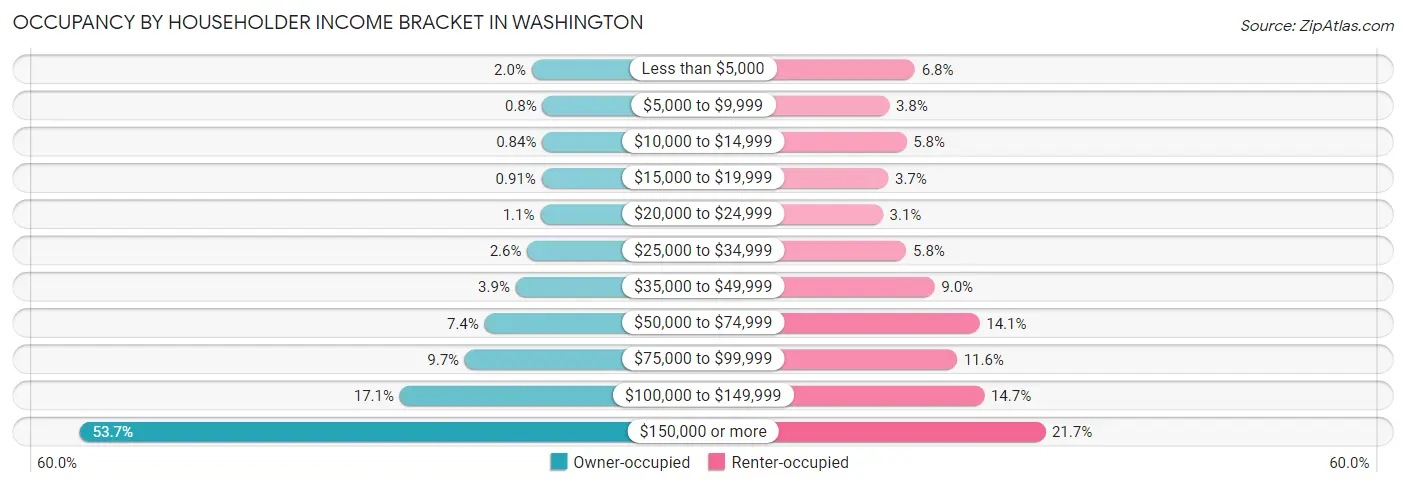
| Income Bracket | Owner-occupied | Renter-occupied |
| Less than $5,000 | 2,664 (2.0%) | 12,512 (6.8%) |
| $5,000 to $9,999 | 1,045 (0.8%) | 7,066 (3.8%) |
| $10,000 to $14,999 | 1,094 (0.8%) | 10,725 (5.8%) |
| $15,000 to $19,999 | 1,189 (0.9%) | 6,852 (3.7%) |
| $20,000 to $24,999 | 1,393 (1.1%) | 5,709 (3.1%) |
| $25,000 to $34,999 | 3,338 (2.5%) | 10,681 (5.8%) |
| $35,000 to $49,999 | 5,060 (3.9%) | 16,667 (9.0%) |
| $50,000 to $74,999 | 9,721 (7.4%) | 26,156 (14.1%) |
| $75,000 to $99,999 | 12,665 (9.7%) | 21,379 (11.6%) |
| $100,000 to $149,999 | 22,403 (17.1%) | 27,140 (14.7%) |
| $150,000 or more | 70,293 (53.7%) | 40,033 (21.6%) |
| Total | 130,865 (100.0%) | 184,920 (100.0%) |
Monthly Housing Cost Tiers in Washington

| Monthly Cost | Owner-occupied | Renter-occupied |
| Less than $300 | 2,627 (2.0%) | 8,019 (4.3%) |
| $300 to $499 | 5,487 (4.2%) | 6,851 (3.7%) |
| $500 to $799 | 8,612 (6.6%) | 7,307 (4.0%) |
| $800 to $999 | 5,384 (4.1%) | 8,065 (4.4%) |
| $1,000 to $1,499 | 13,629 (10.4%) | 34,782 (18.8%) |
| $1,500 to $1,999 | 14,626 (11.2%) | 40,355 (21.8%) |
| $2,000 to $2,499 | 16,330 (12.5%) | 28,691 (15.5%) |
| $2,500 to $2,999 | 14,813 (11.3%) | 19,639 (10.6%) |
| $3,000 or more | 49,357 (37.7%) | 27,463 (14.8%) |
| Total | 130,865 (100.0%) | 184,920 (100.0%) |
Physical Housing Characteristics in Washington
Housing Structures in Washington

| Structure Type | # Housing Units | % Housing Units |
| Single Unit, Detached | 37,556 | 11.9% |
| Single Unit, Attached | 72,453 | 22.9% |
| 2 Unit Apartments | 10,440 | 3.3% |
| 3 or 4 Unit Apartments | 22,408 | 7.1% |
| 5 to 9 Unit Apartments | 22,575 | 7.1% |
| 10 or more Apartments | 150,024 | 47.5% |
| Mobile Home / Other | 329 | 0.1% |
| Total | 315,785 | 100.0% |
Housing Structures by Occupancy in Washington

| Structure Type | Owner-occupied | Renter-occupied |
| Single Unit, Detached | 32,261 (85.9%) | 5,295 (14.1%) |
| Single Unit, Attached | 56,223 (77.6%) | 16,230 (22.4%) |
| 2 Unit Apartments | 3,497 (33.5%) | 6,943 (66.5%) |
| 3 or 4 Unit Apartments | 3,709 (16.6%) | 18,699 (83.5%) |
| 5 to 9 Unit Apartments | 4,776 (21.2%) | 17,799 (78.8%) |
| 10 or more Apartments | 30,356 (20.2%) | 119,668 (79.8%) |
| Mobile Home / Other | 43 (13.1%) | 286 (86.9%) |
| Total | 130,865 (41.4%) | 184,920 (58.6%) |
Housing Structures by Number of Rooms in Washington

| Number of Rooms | Owner-occupied | Renter-occupied |
| 1 Room | 2,204 (1.7%) | 23,816 (12.9%) |
| 2 or 3 Rooms | 20,483 (15.7%) | 83,931 (45.4%) |
| 4 or 5 Rooms | 32,471 (24.8%) | 56,102 (30.3%) |
| 6 or 7 Rooms | 35,880 (27.4%) | 14,702 (8.0%) |
| 8 or more Rooms | 39,827 (30.4%) | 6,369 (3.4%) |
| Total | 130,865 (100.0%) | 184,920 (100.0%) |
Housing Structure by Heating Type in Washington

| Heating Type | Owner-occupied | Renter-occupied |
| Utility Gas | 86,308 (65.9%) | 72,596 (39.3%) |
| Bottled, Tank, or LP Gas | 1,230 (0.9%) | 1,947 (1.1%) |
| Electricity | 39,699 (30.3%) | 101,556 (54.9%) |
| Fuel Oil or Kerosene | 1,541 (1.2%) | 1,366 (0.7%) |
| Coal or Coke | 13 (0.0%) | 0 (0.0%) |
| All other Fuels | 989 (0.8%) | 2,135 (1.1%) |
| No Fuel Used | 1,085 (0.8%) | 5,320 (2.9%) |
| Total | 130,865 (100.0%) | 184,920 (100.0%) |
Household Vehicle Usage in Washington

| Vehicles per Household | Owner-occupied | Renter-occupied |
| No Vehicle | 20,745 (15.9%) | 92,017 (49.8%) |
| 1 Vehicle | 69,411 (53.0%) | 75,469 (40.8%) |
| 2 Vehicles | 31,959 (24.4%) | 14,905 (8.1%) |
| 3 or more Vehicles | 8,750 (6.7%) | 2,529 (1.4%) |
| Total | 130,865 (100.0%) | 184,920 (100.0%) |
Real Estate & Mortgages in Washington
Real Estate and Mortgage Overview in Washington
| Characteristic | Without Mortgage | With Mortgage |
| Housing Units | 31,753 | 99,112 |
| Median Property Value | $704,400 | $705,200 |
| Median Household Income | $117,459 | $58,132 |
| Monthly Housing Costs | $821 | $48,396 |
| Real Estate Taxes | $3,488 | $1,909 |
Property Value by Mortgage Status in Washington

| Property Value | Without Mortgage | With Mortgage |
| Less than $50,000 | 573 (1.8%) | 833 (0.8%) |
| $50,000 to $99,999 | 238 (0.7%) | 243 (0.3%) |
| $100,000 to $299,999 | 3,477 (11.0%) | 6,199 (6.2%) |
| $300,000 to $499,999 | 6,287 (19.8%) | 21,827 (22.0%) |
| $500,000 to $749,999 | 6,485 (20.4%) | 24,924 (25.2%) |
| $750,000 to $999,999 | 5,473 (17.2%) | 18,491 (18.7%) |
| $1,000,000 or more | 9,220 (29.0%) | 26,595 (26.8%) |
| Total | 31,753 (100.0%) | 99,112 (100.0%) |
Household Income by Mortgage Status in Washington

| Household Income | Without Mortgage | With Mortgage |
| Less than $10,000 | 1,701 (5.4%) | 1,205 (1.2%) |
| $10,000 to $24,999 | 1,817 (5.7%) | 2,008 (2.0%) |
| $25,000 to $34,999 | 1,421 (4.5%) | 1,859 (1.9%) |
| $35,000 to $49,999 | 2,088 (6.6%) | 1,917 (1.9%) |
| $50,000 to $74,999 | 3,537 (11.1%) | 2,972 (3.0%) |
| $75,000 to $99,999 | 3,302 (10.4%) | 6,184 (6.2%) |
| $100,000 to $149,999 | 5,726 (18.0%) | 9,363 (9.5%) |
| $150,000 or more | 12,161 (38.3%) | 16,677 (16.8%) |
| Total | 31,753 (100.0%) | 99,112 (100.0%) |
Property Value to Household Income Ratio in Washington

| Value-to-Income Ratio | Without Mortgage | With Mortgage |
| Less than 2.0x | 3,518 (11.1%) | 178,717 (180.3%) |
| 2.0x to 2.9x | 3,798 (12.0%) | 12,101 (12.2%) |
| 3.0x to 3.9x | 4,236 (13.3%) | 20,679 (20.9%) |
| 4.0x or more | 19,505 (61.4%) | 20,509 (20.7%) |
| Total | 31,753 (100.0%) | 99,112 (100.0%) |
Real Estate Taxes by Mortgage Status in Washington

| Property Taxes | Without Mortgage | With Mortgage |
| Less than $800 | 2,428 (7.6%) | 435 (0.4%) |
| $800 to $1,499 | 4,511 (14.2%) | 5,092 (5.1%) |
| $800 to $1,499 | 23,047 (72.6%) | 8,814 (8.9%) |
| Total | 31,753 (100.0%) | 99,112 (100.0%) |
Health & Disability in Washington
Health Insurance Coverage by Age in Washington

| Age Bracket | With Coverage | Without Coverage |
| Under 6 Years | 47,278 (97.3%) | 1,296 (2.7%) |
| 6 to 18 Years | 81,447 (97.5%) | 2,063 (2.5%) |
| 19 to 25 Years | 63,370 (94.9%) | 3,425 (5.1%) |
| 26 to 34 Years | 130,335 (95.9%) | 5,647 (4.2%) |
| 35 to 44 Years | 102,153 (96.0%) | 4,219 (4.0%) |
| 45 to 54 Years | 68,811 (95.7%) | 3,094 (4.3%) |
| 55 to 64 Years | 63,825 (96.4%) | 2,403 (3.6%) |
| 65 to 74 Years | 47,767 (99.1%) | 422 (0.9%) |
| 75 Years and older | 34,018 (99.9%) | 23 (0.1%) |
| Total | 639,004 (96.6%) | 22,592 (3.4%) |
Health Insurance Coverage by Citizenship Status in Washington

| Citizenship Status | With Coverage | Without Coverage |
| Native Born | 47,278 (97.3%) | 1,296 (2.7%) |
| Foreign Born, Citizen | 81,447 (97.5%) | 2,063 (2.5%) |
| Foreign Born, not a Citizen | 63,370 (94.9%) | 3,425 (5.1%) |
Health Insurance Coverage by Household Income in Washington

| Household Income | With Coverage | Without Coverage |
| Under $25,000 | 82,182 (94.7%) | 4,606 (5.3%) |
| $25,000 to $49,999 | 63,862 (94.0%) | 4,093 (6.0%) |
| $50,000 to $74,999 | 59,517 (93.7%) | 3,979 (6.3%) |
| $75,000 to $99,999 | 54,640 (96.2%) | 2,173 (3.8%) |
| $100,000 and over | 357,904 (98.3%) | 6,145 (1.7%) |
Public vs Private Health Insurance Coverage by Age in Washington

| Age Bracket | Public Insurance | Private Insurance |
| Under 6 | 19,203 (39.5%) | 29,985 (61.7%) |
| 6 to 18 Years | 40,260 (48.2%) | 44,641 (53.5%) |
| 19 to 25 Years | 15,043 (22.5%) | 50,383 (75.4%) |
| 25 to 34 Years | 21,548 (15.9%) | 111,632 (82.1%) |
| 35 to 44 Years | 20,208 (19.0%) | 85,591 (80.5%) |
| 45 to 54 Years | 17,212 (23.9%) | 54,338 (75.6%) |
| 55 to 64 Years | 21,474 (32.4%) | 45,906 (69.3%) |
| 65 to 74 Years | 41,774 (86.7%) | 31,017 (64.4%) |
| 75 Years and over | 32,885 (96.6%) | 22,369 (65.7%) |
| Total | 229,607 (34.7%) | 475,862 (71.9%) |
Disability Status by Sex by Age in Washington

| Age Bracket | Male | Female |
| Under 5 Years | 341 (1.6%) | 64 (0.3%) |
| 5 to 17 Years | 2,670 (6.4%) | 2,227 (5.4%) |
| 18 to 34 Years | 5,731 (5.9%) | 5,999 (5.3%) |
| 35 to 64 Years | 12,781 (10.6%) | 16,002 (12.9%) |
| 65 to 74 Years | 4,888 (23.3%) | 6,735 (24.7%) |
| 75 Years and over | 5,102 (39.6%) | 10,119 (47.8%) |
Disability Class by Sex by Age in Washington
Disability Class: Hearing Difficulty

| Age Bracket | Male | Female |
| Under 5 Years | 341 (1.6%) | 64 (0.3%) |
| 5 to 17 Years | 260 (0.6%) | 151 (0.4%) |
| 18 to 34 Years | 646 (0.7%) | 665 (0.6%) |
| 35 to 64 Years | 2,182 (1.8%) | 1,651 (1.3%) |
| 65 to 74 Years | 913 (4.4%) | 859 (3.2%) |
| 75 Years and over | 2,077 (16.1%) | 2,709 (12.8%) |
Disability Class: Vision Difficulty

| Age Bracket | Male | Female |
| Under 5 Years | 149 (0.7%) | 49 (0.2%) |
| 5 to 17 Years | 369 (0.9%) | 545 (1.3%) |
| 18 to 34 Years | 1,406 (1.5%) | 958 (0.8%) |
| 35 to 64 Years | 3,002 (2.5%) | 3,297 (2.7%) |
| 65 to 74 Years | 1,285 (6.1%) | 1,302 (4.8%) |
| 75 Years and over | 744 (5.8%) | 1,534 (7.2%) |
Disability Class: Cognitive Difficulty

| Age Bracket | Male | Female |
| 5 to 17 Years | 2,261 (5.4%) | 1,652 (4.1%) |
| 18 to 34 Years | 3,417 (3.5%) | 3,855 (3.4%) |
| 35 to 64 Years | 6,288 (5.2%) | 5,723 (4.6%) |
| 65 to 74 Years | 1,249 (6.0%) | 1,252 (4.6%) |
| 75 Years and over | 1,383 (10.7%) | 2,754 (13.0%) |
Disability Class: Ambulatory Difficulty

| Age Bracket | Male | Female |
| 5 to 17 Years | 161 (0.4%) | 205 (0.5%) |
| 18 to 34 Years | 769 (0.8%) | 1,078 (0.9%) |
| 35 to 64 Years | 5,691 (4.7%) | 10,013 (8.1%) |
| 65 to 74 Years | 3,220 (15.4%) | 5,105 (18.7%) |
| 75 Years and over | 3,197 (24.8%) | 7,446 (35.2%) |
Disability Class: Self-Care Difficulty

| Age Bracket | Male | Female |
| 5 to 17 Years | 509 (1.2%) | 407 (1.0%) |
| 18 to 34 Years | 617 (0.6%) | 545 (0.5%) |
| 35 to 64 Years | 1,964 (1.6%) | 2,566 (2.1%) |
| 65 to 74 Years | 1,017 (4.9%) | 1,427 (5.2%) |
| 75 Years and over | 1,052 (8.2%) | 2,929 (13.8%) |
Technology Access in Washington
Computing Device Access in Washington

| Device Type | # Households | % Households |
| Desktop or Laptop | 264,864 | 83.9% |
| Smartphone | 290,171 | 91.9% |
| Tablet | 203,928 | 64.6% |
| No Computing Device | 14,676 | 4.6% |
| Total | 315,785 | 100.0% |
Internet Access in Washington

| Internet Type | # Households | % Households |
| Dial-Up Internet | 292 | 0.1% |
| Broadband Home | 248,241 | 78.6% |
| Cellular Data Only | 27,422 | 8.7% |
| Satellite Internet | 11,014 | 3.5% |
| No Internet | 34,361 | 10.9% |
| Total | 315,785 | 100.0% |
Washington Summary
Washington, DC is the capital of the United States and the seat of the federal government. It is located on the Potomac River, between Maryland and Virginia. The city is home to the White House, the Capitol, the Supreme Court, and numerous other federal buildings and monuments. It is also home to a vibrant and diverse population of over 700,000 people.
History
Washington, DC was founded in 1790 as the nation’s capital. It was named after George Washington, the first president of the United States. The city was designed by Pierre Charles L’Enfant, a French-born architect and engineer. The city was planned to be a grand capital city, with wide avenues, parks, and public buildings.
In 1800, the federal government moved to Washington, DC from Philadelphia. The city grew rapidly, and by the mid-1800s, it was home to a population of over 60,000 people. During the Civil War, Washington, DC was the site of several battles, including the Battle of Fort Stevens.
In the late 1800s, Washington, DC became a major center of African American culture and politics. The city was home to a large African American population, and it was the site of several important civil rights events, including the March on Washington in 1963.
Geography
Washington, DC is located in the Mid-Atlantic region of the United States. It is bordered by Maryland to the north and east, and Virginia to the south and west. The city is situated on the Potomac River, which forms the border between Maryland and Virginia.
The city is divided into four quadrants: Northwest, Northeast, Southeast, and Southwest. The city is divided into eight wards, each of which is represented by a councilmember. The city is also divided into neighborhoods, such as Capitol Hill, Georgetown, and Anacostia.
The city is home to numerous parks and monuments, including the National Mall, the Lincoln Memorial, and the Washington Monument. The city is also home to several universities, including Georgetown University, George Washington University, and American University.
Economy
Washington, DC is a major center of business and finance. The city is home to numerous federal government agencies, including the Department of Defense, the Department of State, and the Department of the Treasury. The city is also home to numerous international organizations, such as the World Bank and the International Monetary Fund.
The city is home to several Fortune 500 companies, including Fannie Mae, Marriott International, and Lockheed Martin. The city is also home to numerous technology companies, such as Amazon, Google, and Microsoft.
The city’s economy is also supported by tourism. The city is home to numerous museums, monuments, and other attractions, such as the Smithsonian Institution, the National Zoo, and the National Gallery of Art.
Demographics
Washington, DC is home to a diverse population of over 700,000 people. The city is majority African American, with a population that is 48.3% African American, 43.2% White, 4.2% Asian, and 2.3% Hispanic or Latino. The city is also home to a large immigrant population, with over 20% of the population born outside of the United States.
The city has a median household income of $75,506, and a poverty rate of 17.2%. The city’s unemployment rate is 5.2%, which is lower than the national average.
Conclusion
Washington, DC is a vibrant and diverse city with a rich history and a thriving economy. The city is home to numerous federal government agencies, international organizations, and Fortune 500 companies. It is also home to a diverse population of over 700,000 people. The city is a major center of business and finance, and it is a popular tourist destination.
Common Questions
What is Per Capita Income in Washington?
Per Capita income in Washington is $71,297.
What is the Median Family Income in Washington?
Median Family Income in Washington is $142,328.
What is the Median Household income in Washington?
Median Household Income in Washington is $101,722.
What is Income or Wage Gap in Washington?
Income or Wage Gap in Washington is 13.7%.
Women in Washington earn 86.3 cents for every dollar earned by a man.
What is Family Income Deficit in Washington?
Family Income Deficit in Washington is $13,486.
Families that are below poverty line in Washington earn $13,486 less on average than the poverty threshold level.
What is Inequality or Gini Index in Washington?
Inequality or Gini Index in Washington is 0.52.
What is the Total Population of Washington?
Total Population of Washington is 670,587.
What is the Total Male Population of Washington?
Total Male Population of Washington is 320,797.
What is the Total Female Population of Washington?
Total Female Population of Washington is 349,790.
What is the Ratio of Males per 100 Females in Washington?
There are 91.71 Males per 100 Females in Washington.
What is the Ratio of Females per 100 Males in Washington?
There are 109.04 Females per 100 Males in Washington.
What is the Median Population Age in Washington?
Median Population Age in Washington is 34.8 Years.
What is the Average Family Size in Washington
Average Family Size in Washington is 3.0 People.
What is the Average Household Size in Washington
Average Household Size in Washington is 2.0 People.
How Large is the Labor Force in Washington?
There are 400,882 People in the Labor Forcein in Washington.
What is the Percentage of People in the Labor Force in Washington?
72.0% of People are in the Labor Force in Washington.
What is the Unemployment Rate in Washington?
Unemployment Rate in Washington is 7.1%.